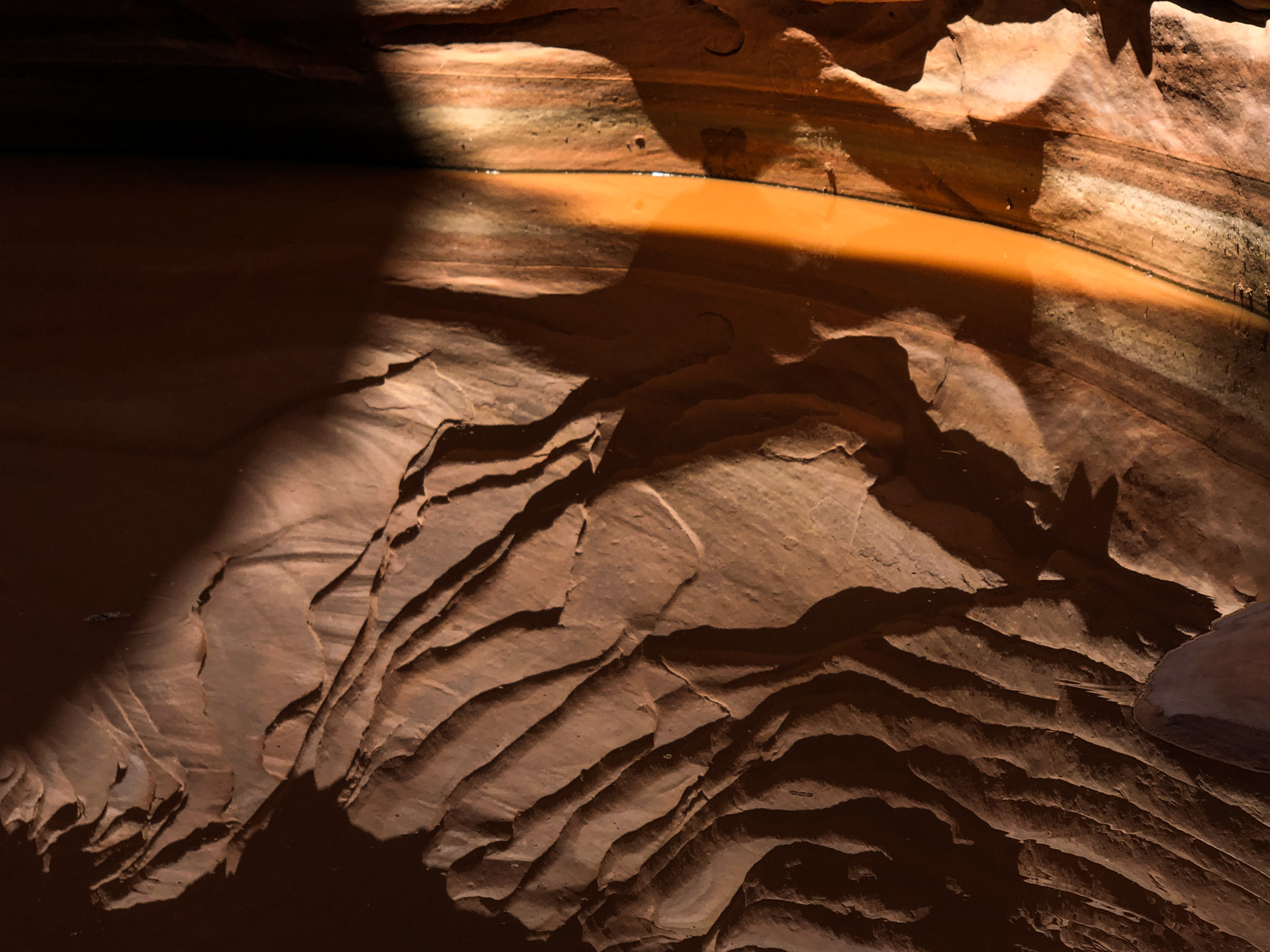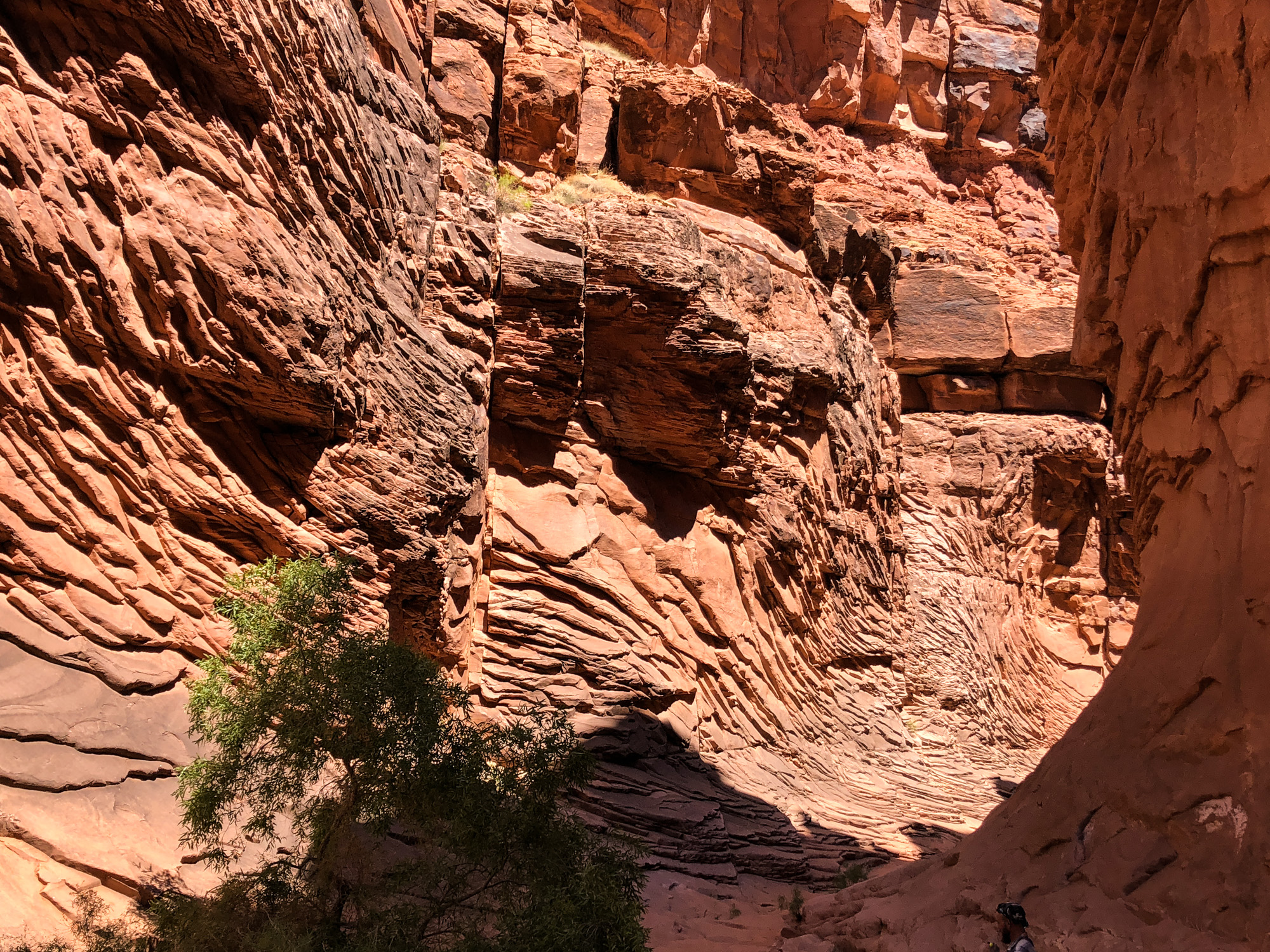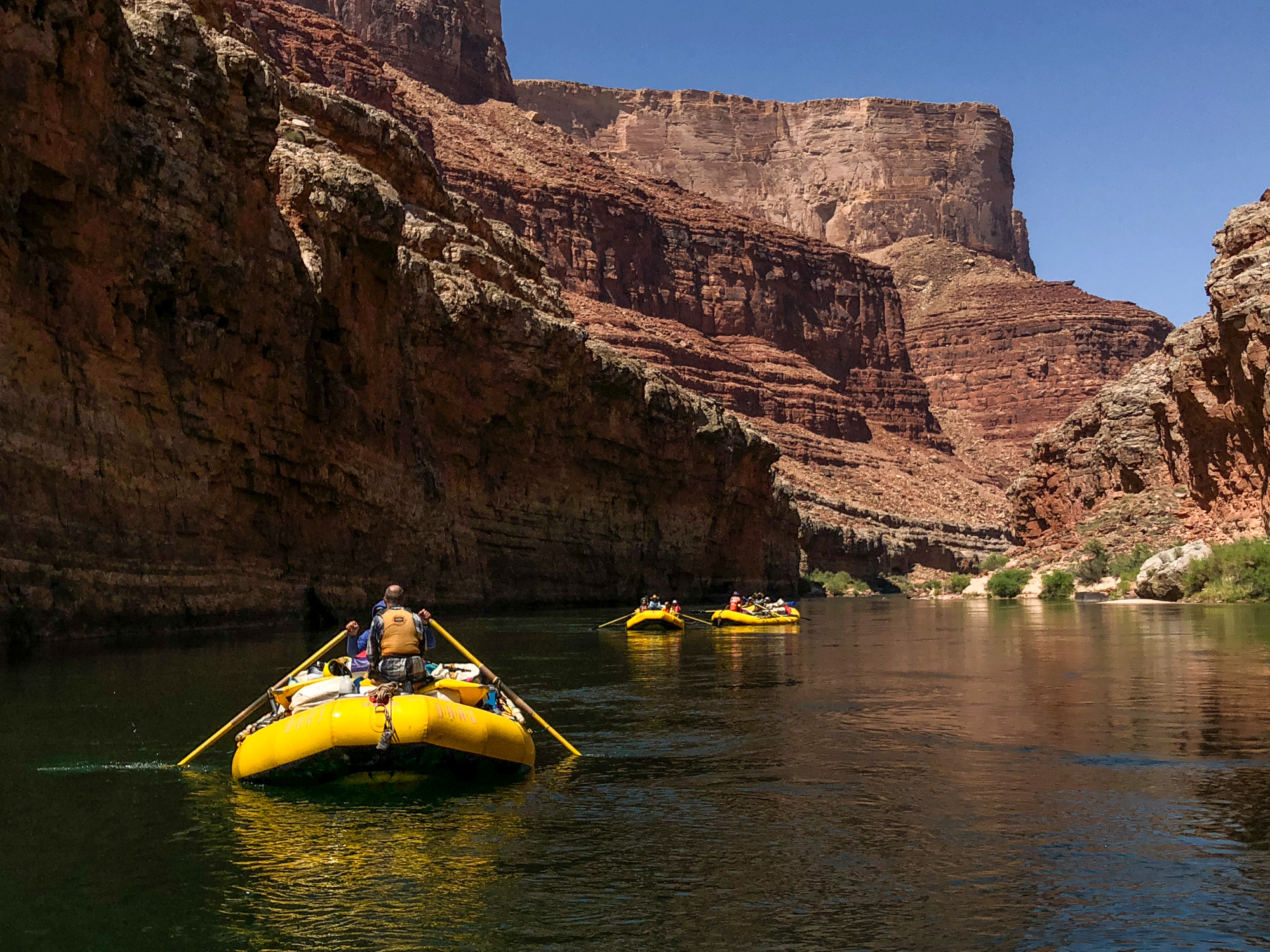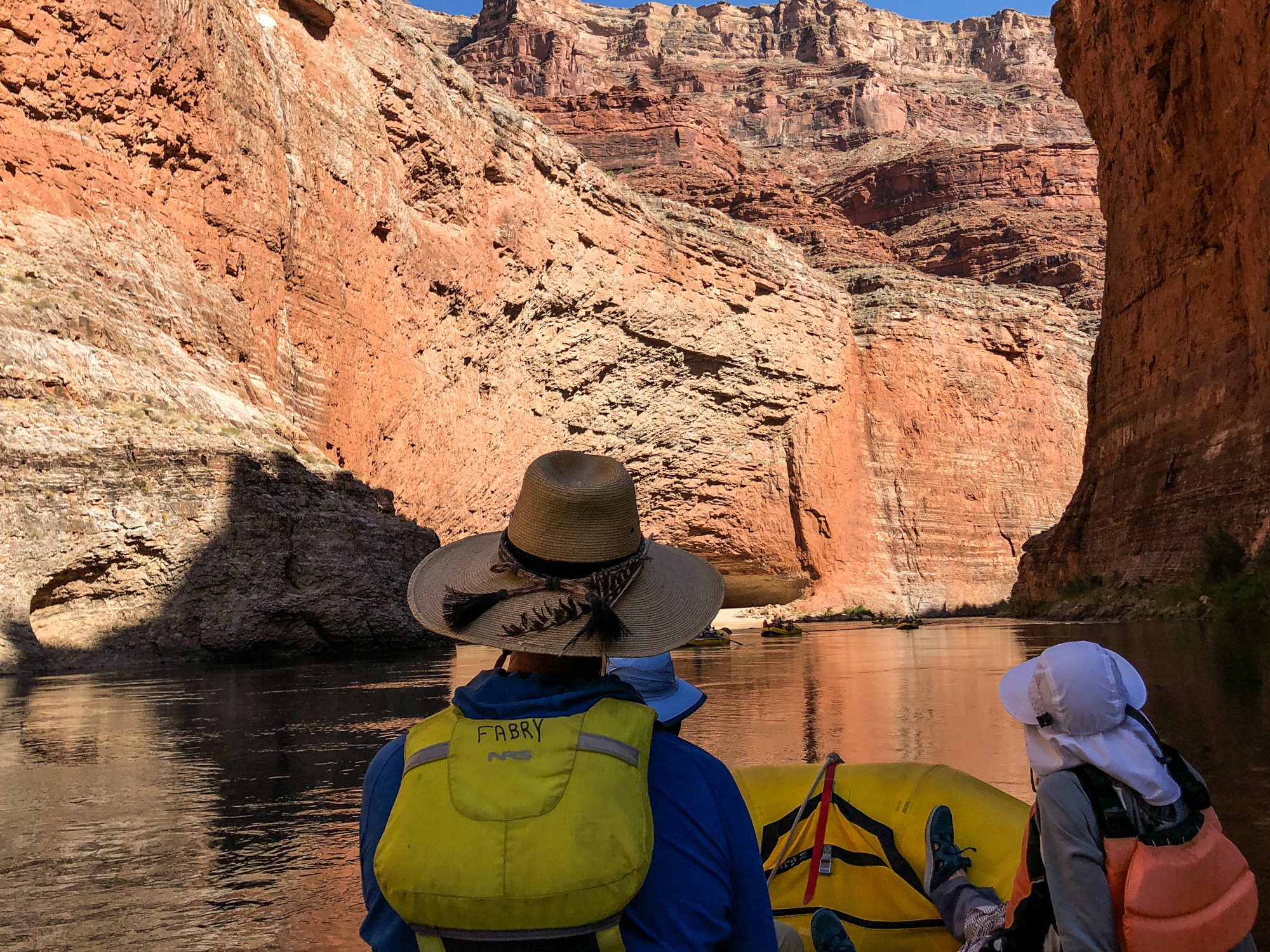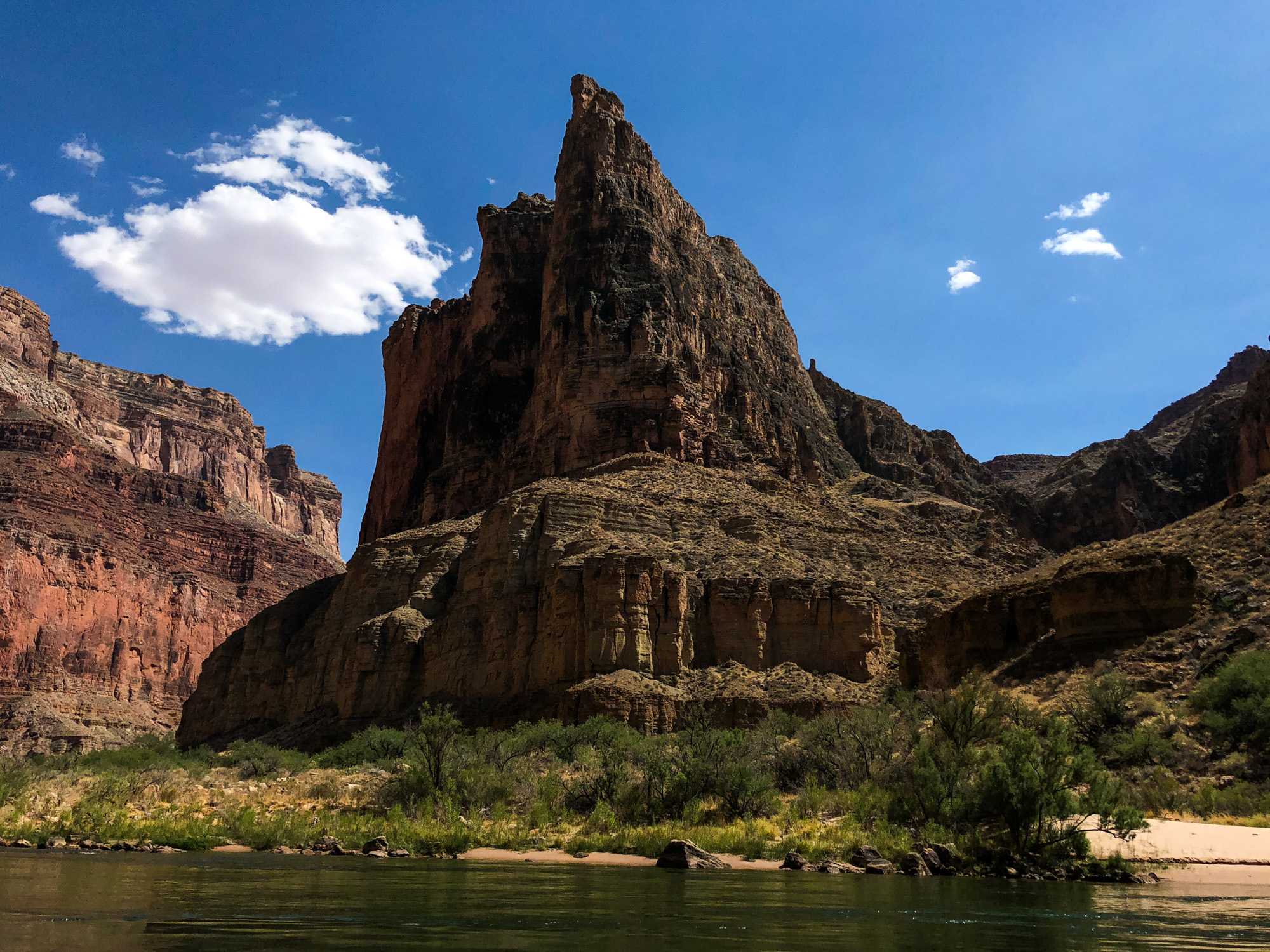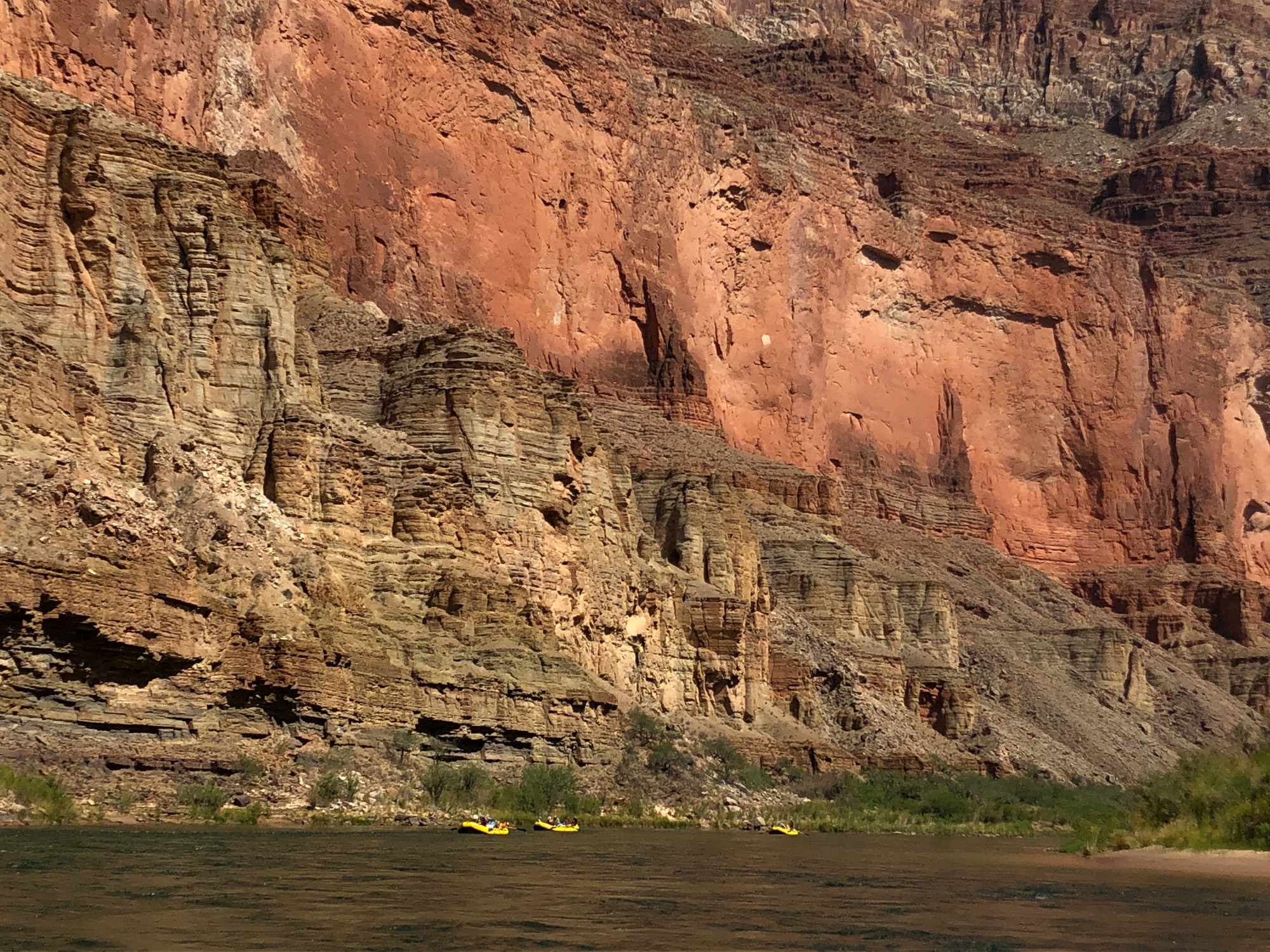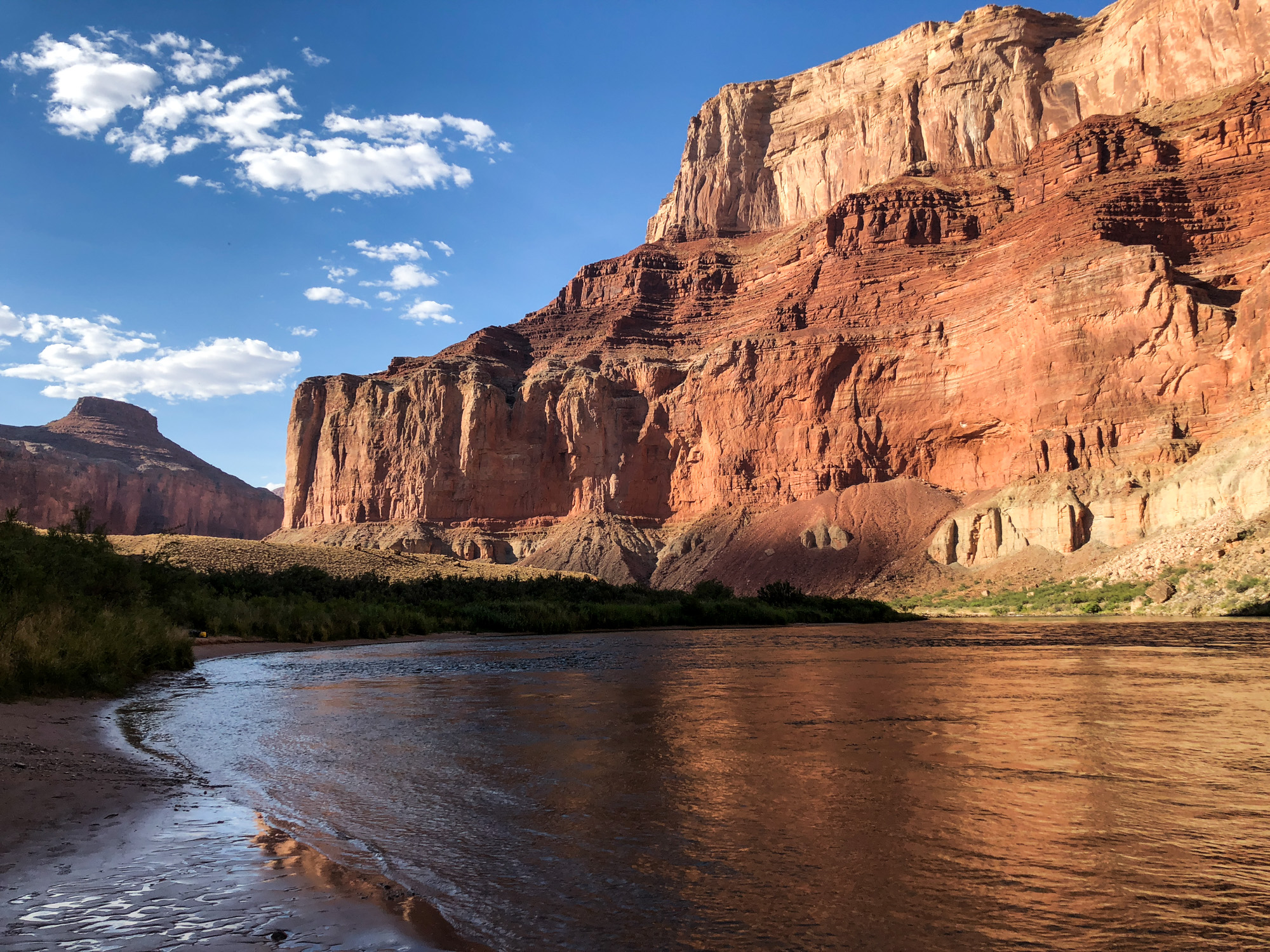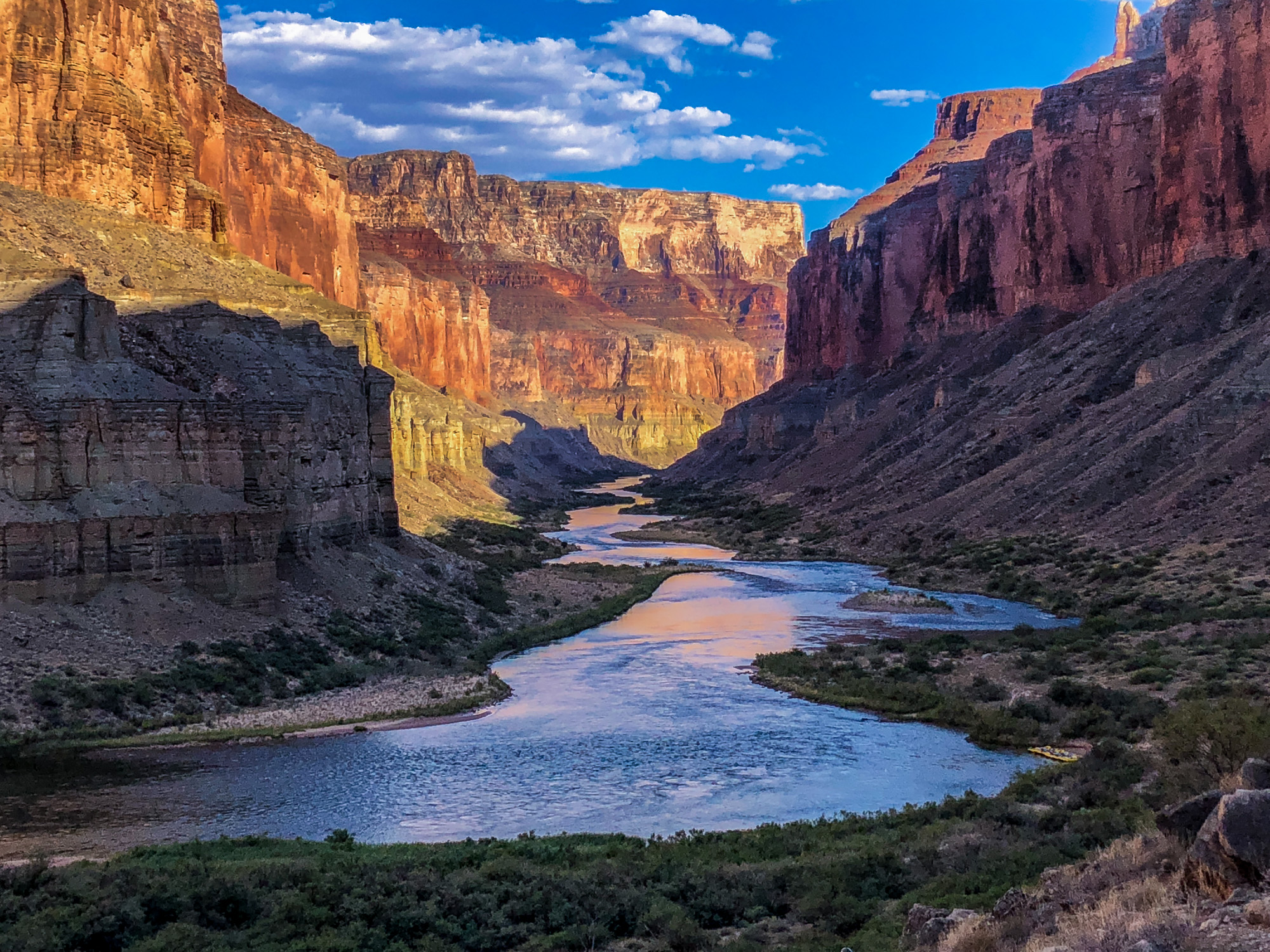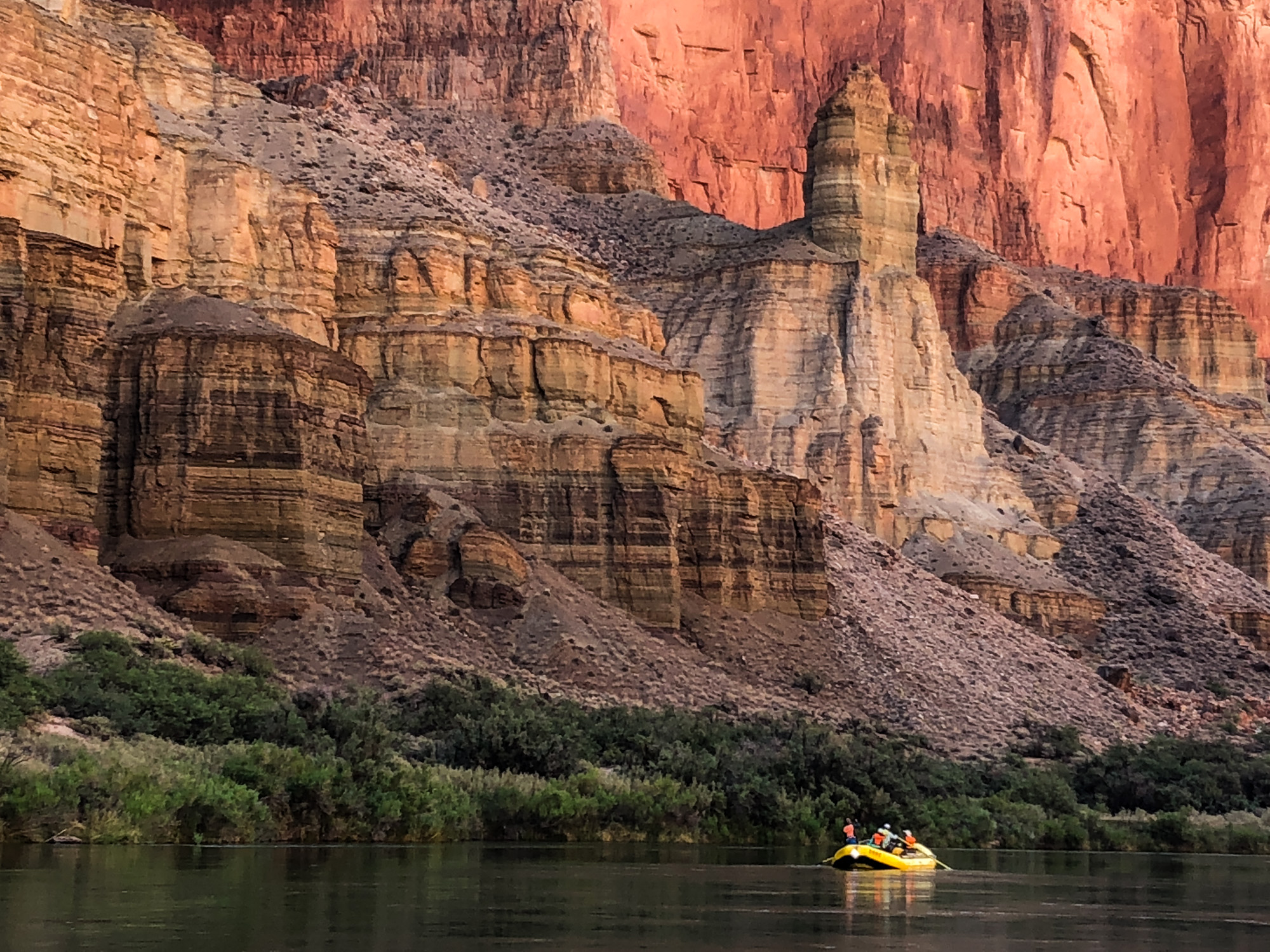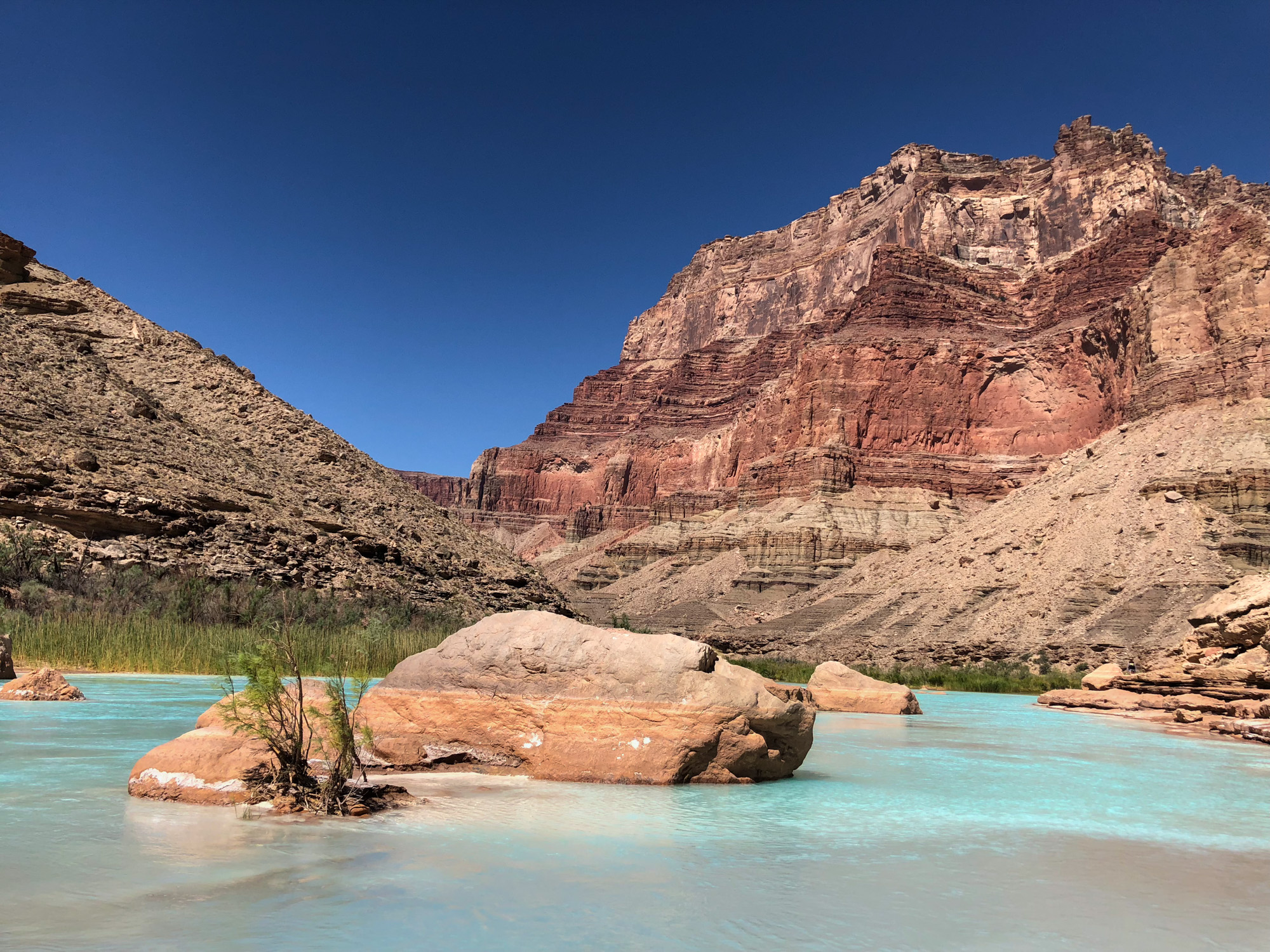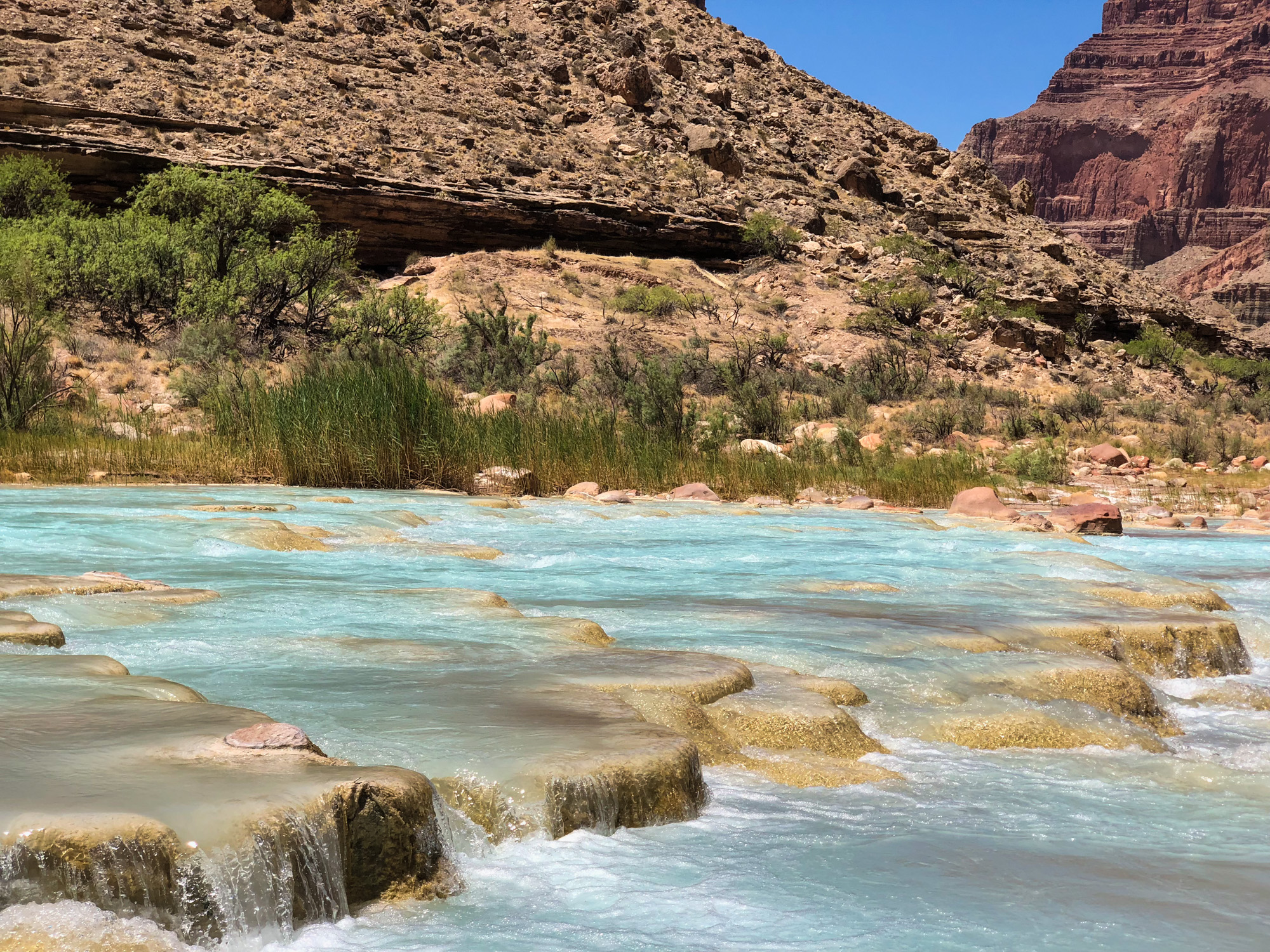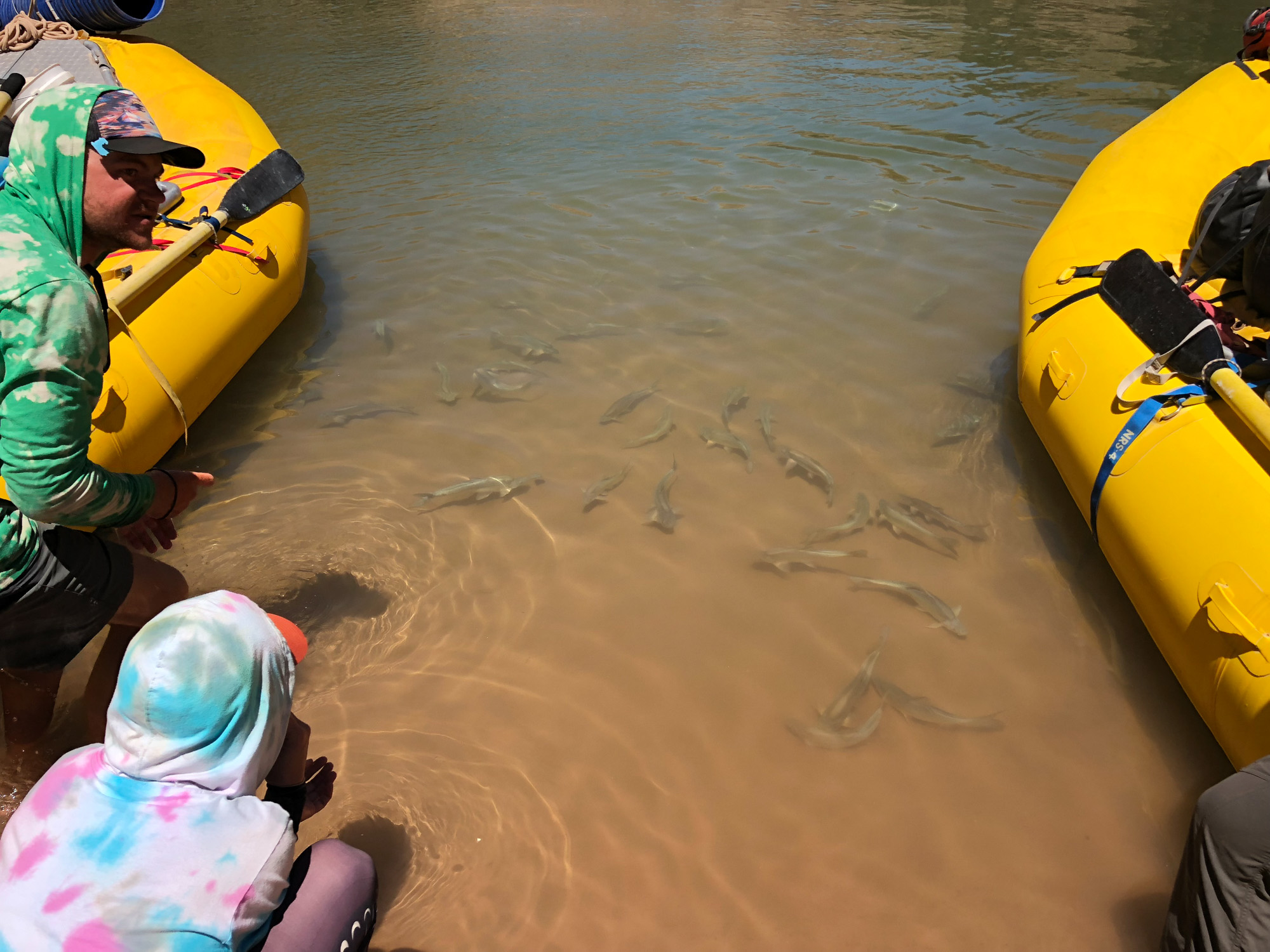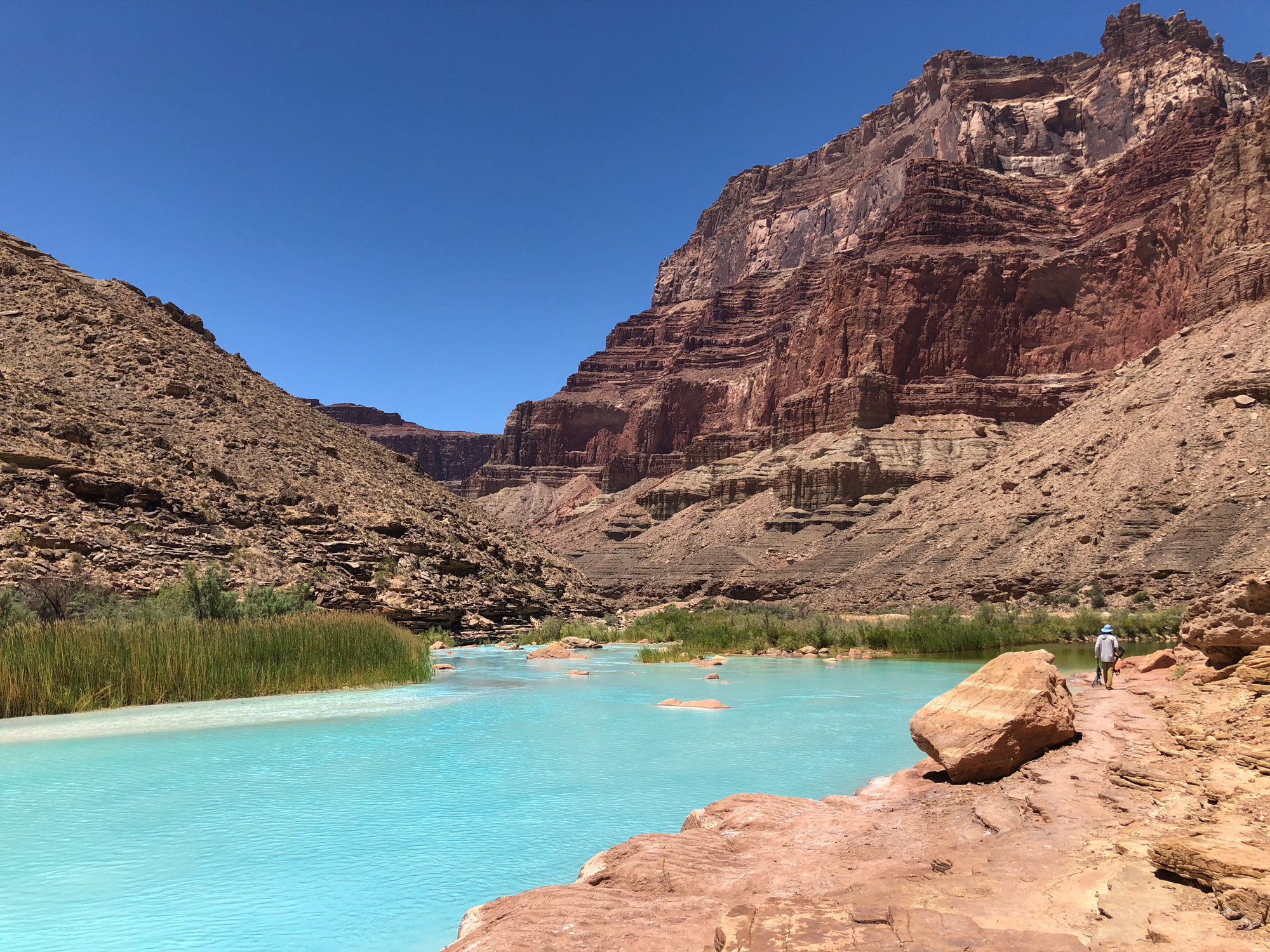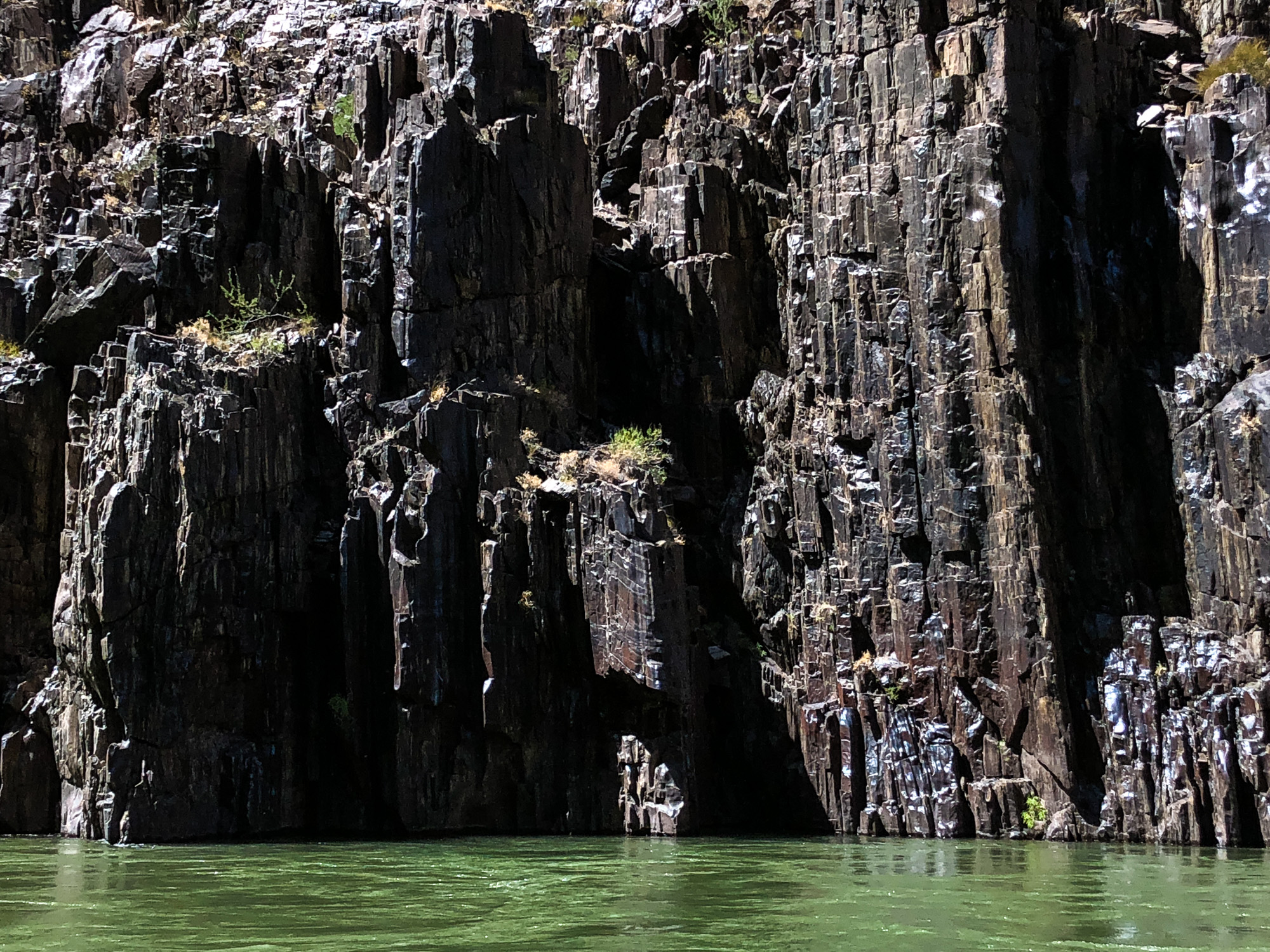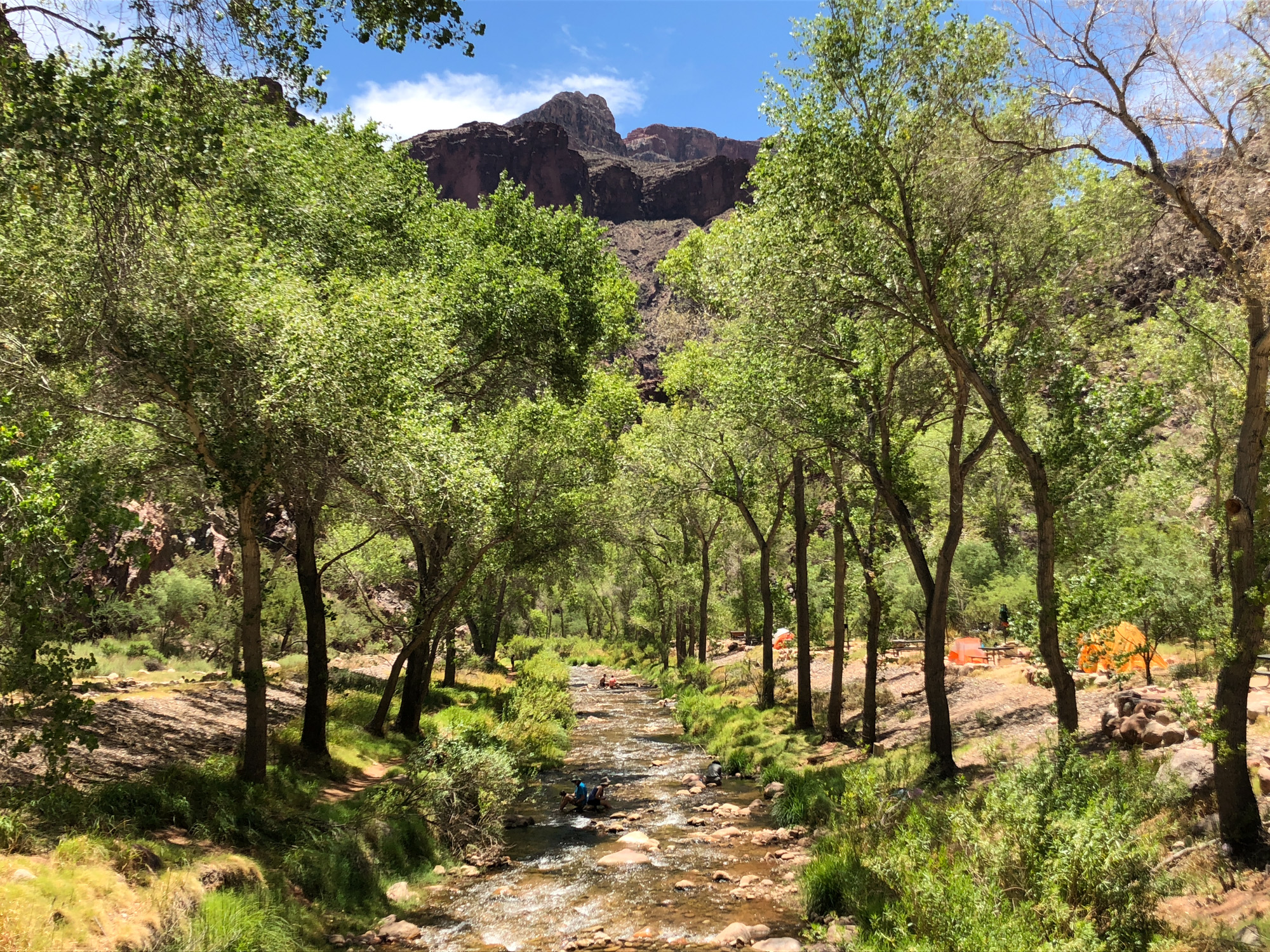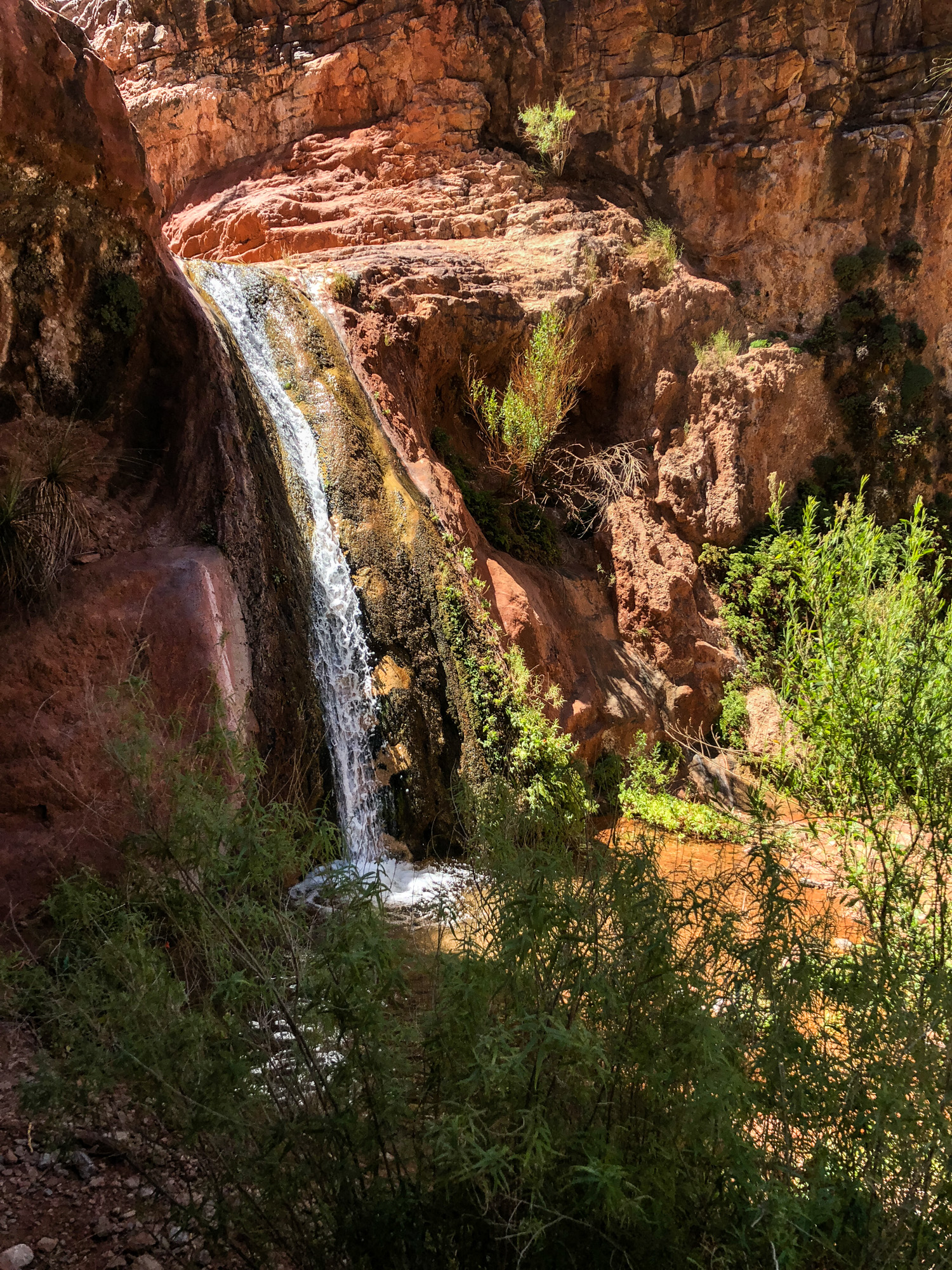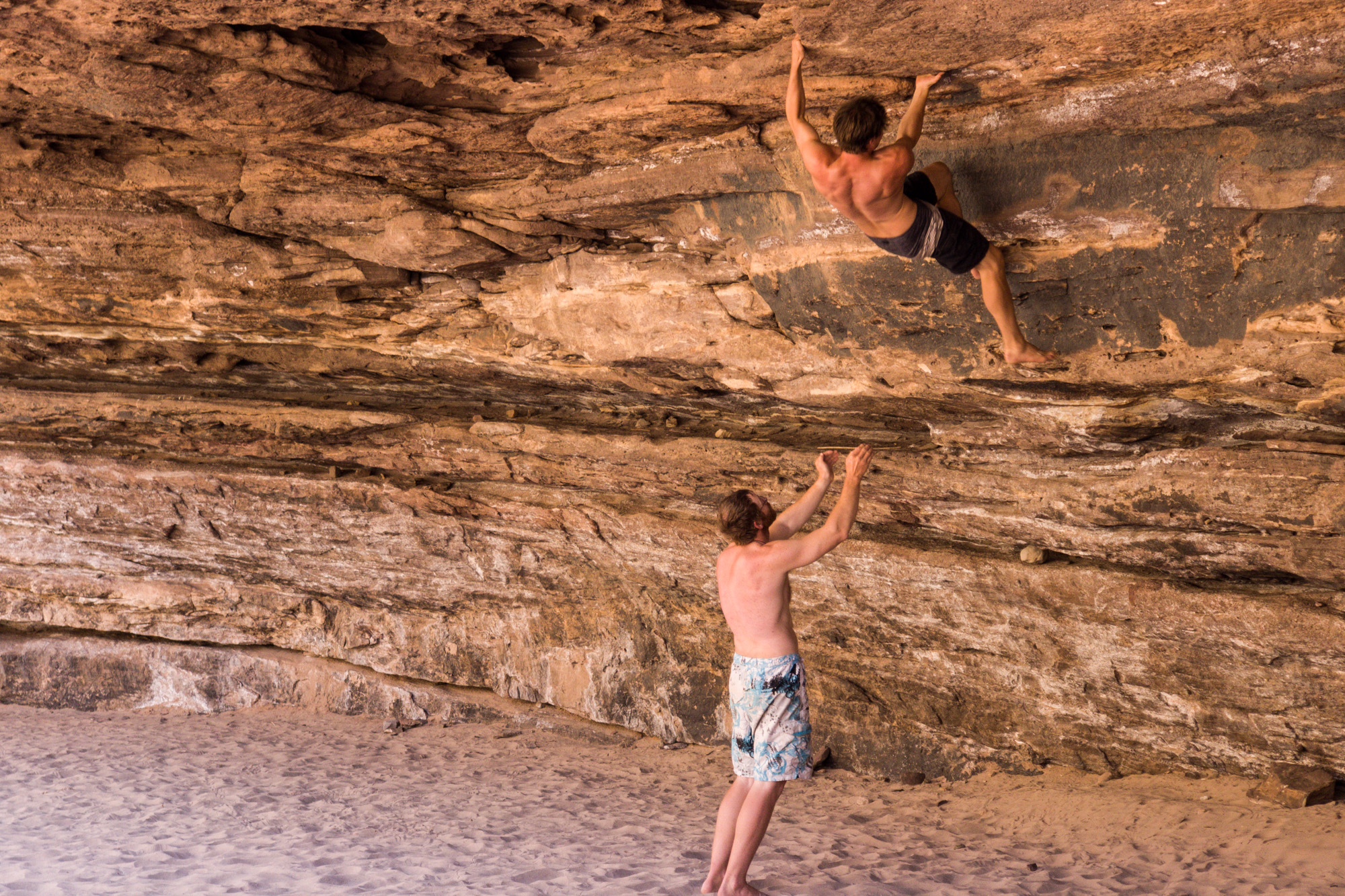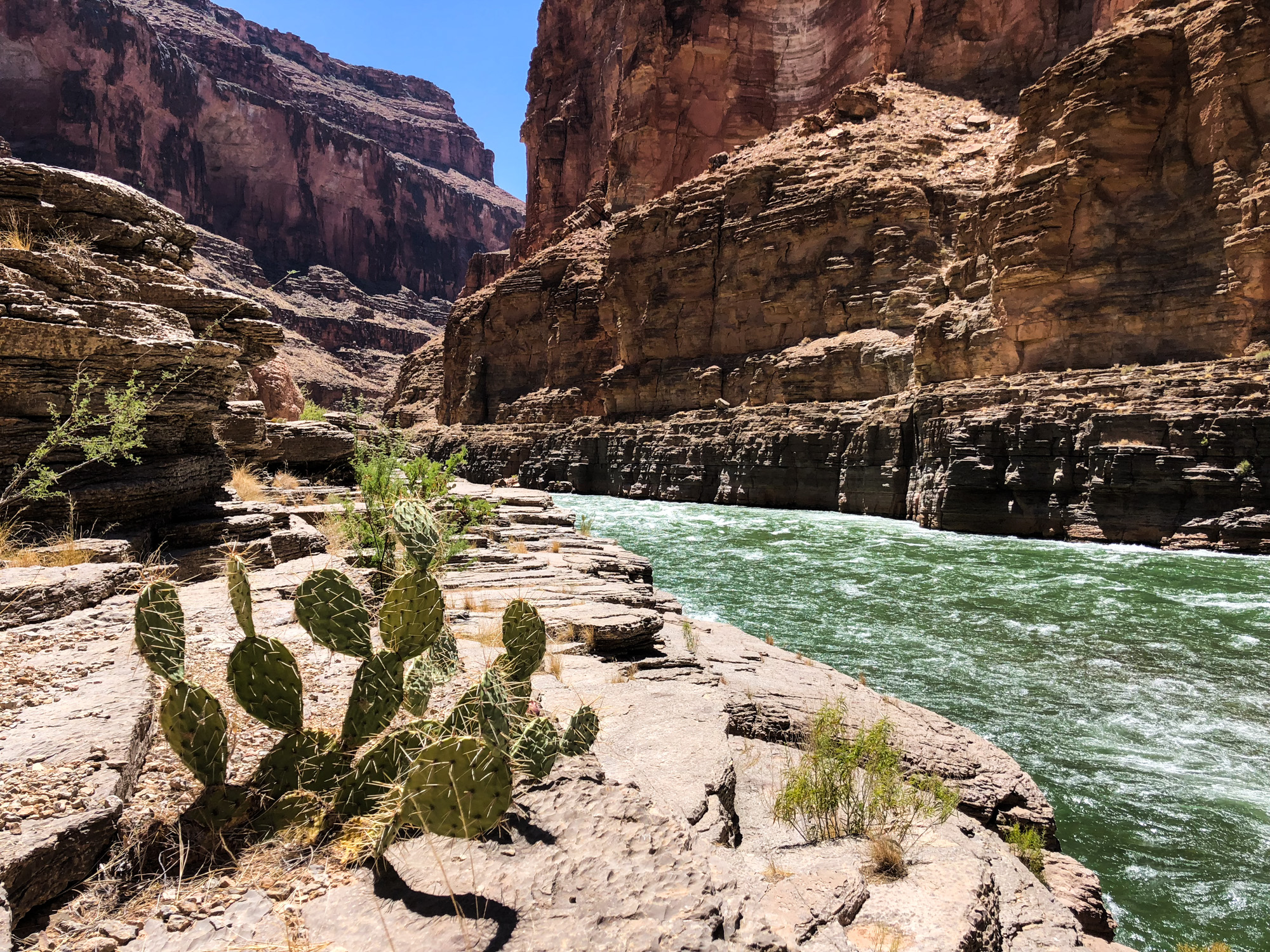Floating 200 miles through the Grand Canyon - 12 Timeless Days - Part 2
“There was nothing else quite like it, the way this river could braid terror and rapture so tightly together.”
The Colorado River at the bottom of the Grand Canyon
Part 2 - Days 6 - 12
During the Summer of 2018, I joined an OARS expedition spending 12 unforgettable days to float almost 200 miles down the Colorado River through the bottom of the Grand Canyon. This is Part 2 of the journey - the remaining 100 miles from Phantom Ranch to Whitmore Wash. You can read the first part here.
Phantom Ranch to Granite Camp
We departed Phantom Ranch at about 1:30 in the afternoon. The air was hot, about 110 degrees. I dipped my hat into the 50 degree water of the Colorado river and poured it over my head to stay cool.
Our rafts slipped into the river and started floating downstream. Overhead was the Silver Suspension bridge bringing hikers and water across the Colorado River. Gliding under the bridge I knew this bridge would be the last remnant of civilization until our trip completes.
Phantom Ranch is in the deepest part of the canyon. The cliffs are ancient metamorphic rock of black Vishnu Schist with winding veins of pink Zoroaster Granite. After 2 Billion years these rocks become very hard. This hardness of this ancient stone make the canyon walls steep and narrow here. There is no shoreline, just cliffs going deep into the green water. Floating a mile beneath the earths surface it is difficult to see the canyon rim high above. The layers of stone in the canyon are like colorful steps leading up to the rim. Trees on the rim are so distant they appear like the frail whiskers of a teen age boy.
Jake and Bird watch as Nathan rows through the Black Vishnu Schist and Pink Zoroaster Granite
Day 6 - Big Whitewater - Granite Camp to Camp 110 - 16 miles
We overnighted at Granite Camp and the next morning, Cliff, our trip leader calmly explained that today we would get very wet as we experienced the biggest single day of whitewater in North America. Beginning with two rapids rated Class "9" difficulty - Granite and Hermit. At Cliff's recommendation we donned our rain gear in an attempt to stay as dry and warm as possible and boarded our rafts. As we pushed off, I felt the cool morning air and noticed that the river was peaceful and calm. But Granite Rapids lies only 100 yards from camp and we were soon within earshot of roaring and fast moving water. Within 60 seconds our raft picked up speed as we moved into the main current. Granite Rapids is big water for about 15 seconds and the waves violent. When water flies everywhere, 15 seconds seems like a long time. We exited Granite Rapids totally drenched. The rain gear was a good call.
The Gems, The Emerald Mile and Crystal Rapids
Downriver of Hermit Rapids are 8 sections of whitewater named "The Gems" - Boucher, Crystal, Tuna, Agate, Sapphire, Turquoise, Ruby and Serpentine. The total drop across the Gems is about 100 ft. With a difficulty rating of 10, Crystal is the most notorious. Many boat guides believe Crystal is the most dangerous section of the Colorado River.
Antifragile
Glen Canyon Dam - Converting the Colorado River to a fragile system
In the book Antifragile Nassim Nicholas Taleb, risk analyst and author, explores the differences of human designed systems that weaken with random stress compared to natural systems that improve through random stress. He describes these natural systems as "antifragile." Antifragile systems in nature, especially living systems, are easy to see. Our muscles strengthen when we apply stress by weight lifting. A runner's bones strengthen through impact stress. Immune systems strengthen with exposure to germs. Extreme, stressful events create a structure in which the living system comfortably exists. Review your life and the uncomfortable, stressful events were likely formative. My personal cancer experience was difficult and stressful but the experience strengthened my character and created "me." Nietzsche recognized "antifragility" when he wrote, “That which does not kill us, makes us stronger.”
Natural rivers are antifragile systems, ebbing and flowing, rising and falling as the weather changes. Rivers and creeks flow through canyons and carve into rock during extreme high water. The gradual process of geomorphic change is punctuated with cataclysmic events like severe weather which transforms a clear river into a muddy slurry. These extreme events break loose weak stones and move obstacles through the river. The river comfortably flows (lives) in the canyon created by extremes. The Glen Canyon Dam was designed to prevent extreme flows and floods on the Colorado River. This "taming of the river" transformed the natural antifragile system into a human-designed fragile system. In 1983 the fragility of the Glen Canyon Dam was stressed to the breaking point.
The Emerald Mile - 1983
In 1983 an El Niño weather pattern produced record storms and snowmelt. The snowcapped mountains in Utah and Colorado birthed floods throughout the western states. High water in Salt Lake City converted streets to rivers. Lake Powell filled to the brim as water flowed in faster than it could flow out. The reservoir rose above the brim of Glen Canyon's concrete. Engineers frantically increased the height of the dam with 4 feet of plywood. The situation was dire. Glen Canyon Dam transformed the antifragile river into a very fragile one. In a desperate attempt to avoid unprecedented disaster, the dam's emergency spillway gates were opened and released water at the highest level since construction. The water flow was so strong the water literally started destroying the spillway from the inside. This documentary explains the dangers and the heroic efforts to save the dam. As the Glen Canyon Dam destroyed itself from within, the Grand Canyon was closed.
People who love the Colorado River tend to dislike dams. The 1983 weather conditions brought great irony because in order to save the dam, the flow from Glen Canyon was increased to 100,000 CFS (about 10X normal). Prior to the dam, this level of flow naturally occurred almost every year but since the dam's construction, it was no longer allowed. Three boatmen saw the irony, Kenton Grua, Steve “Wren” Reynolds and Rudi Petschek, realized the unique opportunity to set a speed record during this high flow. On the evening of June 25, 1983 they launched a wooden dory named The Emerald Mile at Lees Ferry. Since the Grand Canyon was officially closed, the boatmen became outlaws.
To many (including the Park Rangers who were compelled to enforce the laws) these outlaws were Robinhood like. Why? People are naturally drawn to the "Hemingwayesque" heroes in man against nature struggles. But these days our struggles appear more like a "Kafkaesque" man against bureaucracy. This epic outlaw run of the Colorado was both Kafkaesque and Hemmingwayesque in real life. The author describes the conflict of John Thomas (Park Ranger and river guide) as the Emerald Mile dory approaches Crystal Rapids. "Thomas's time on the river had straddled the golden age of guiding. The period in which visitation had skyrocketed from a handful of eccentrics like Martin Litton to tens of thousands of vacationers. Thus he was old enough to remember the freedom that had prevailed in the canyon country before.....back when a man could launch a boat and disappear downstream without having to ask permission.....In truth, no one who tasted those liberties could look back on that time with anything other than a deep sense of longing. Like everyone else who had known the river during that era of innocence, Thomas mourned its passing and privately grieved that it would never return again. Which is why part of him rebelled at the very restrictions he sought to enforce." Thomas chose to look the other way and allow the rebel outlaws to continue their journey.
They made history covering 277 miles in 36 hours and 38 minutes and their record would stand for 33 years. Their journey is chronicled by Kevin Fedarko’s remarkable book, The Emerald Mile. This NPR interview provides insight into their epic adventure and explores the river's history and culture.
Creation of Crystal Rapids
The Emerald Mile details the Crystal Rapid formation and why it is uniquely dangerous. Rapids are formed where small creeks flow into the main river. During severe storms, these small creeks turn into violent slurries and deliver rocks and boulders into the river. During December 1966 the skies opened up with biblical rains and flash floods. Chocolate colored slurries flowed down many of the washes, including Crystal Creek. The creek transformed into a cascade of boulders and mud. Crystal Creek's debris flow created Crystal Rapids, a new rapid worthy of its reputation as the most treacherous rapid on the Colorado. In February of 1967 an emergency letter warned all river guides and outfitters of this new danger. In the past, whenever a debris flow created a new rapid like Crystal, the surging flow of the Colorado River also rose and cleared the debris, maturing young rapids making them safer to navigate. But in 1963 the Glen Canyon dam stifled the natural flow from the Colorado. Crystal Rapids never matured and remains a menace to boaters to this day. The dangers of Crystal Rapids are a direct consequence of fragility introduced by Glen Canyon Dam.
Our run down Crystal Rapids
Since the beginning of our trip, we ran stretches of violent rapids and steadily gained confidence. However, our guides explained that running Crystal was different. We stopped our boats above Crystal in order to scout the behemoth. Cliff and the experienced riverguides shared their perspectives and experiences with new guides and passengers. The Emerald Mile dory flipped in Crystal. This section of water deserves respect. We needed to concentrate on this whitewater run and be prepared to assist the other boats if needed.
Above the rapid lies a deceivingly tranquil pool. I was in the first boat with Cliff as he confidently pulled the oars and scanned the horizon of the pool and patiently searched for the line he had located from the rocks above. The roar of the falls was deafening as we glided slowly toward the point of no return. Finally the rapids came into view and Cliff reminded us to hold on tight.
BOOM. We hit the first wave and our raft shuddered. Water everywhere but we were secure. BOOM, again. BOOM, the last big wave crashed over our heads. Did we flip? No! After 20 seconds the water quickly calmed and so did we. Cliff deftly rotated our raft to watch the other boats. One by one, the passenger rafts, piloted by the most experienced river guides, emerged safely. The luggage rafts followed. This was the inaugural journey for one guide. All eyes focused on that raft and all hearts hoped for a successful run.
The raft carried 2 people - the river guide and her helper, Ruth who is the mother of 3 river guides, including Mariah. We watched in horror as the Crystal Rapids lifted their raft out of the water like a small toy. The guide ejected like popcorn. Ruth scrambled to action. Ruth is an exceptional woman with a cool head. She used her weight to steady the boat and reached to help the swimming guide. Within 3 seconds the guide was again aboard and securing the oars. Whew! Everyone was safe so we all breathed a bit slower. A bit calmer. Watching a potential capsize served as a reminder that the risks in the river are real.
Shinumo Creek Waterfall
Me relaxing on the rocks worn smooth by eons of water flow.
We beached our rafts at Shinumo Creek for a well deserved rest. As we walked up the creek, we entered a party zone because of other groups were also taking a break. After running this section everyone needed a little down time. Screams of joy echoed off the slot canyon walls. People were sitting in the creek and making a human dam forcing water to pool behind them. Water pressure built to the point where the dam burst and bodies careened down the creek like joyfully screaming confetti.
We felt immediate kinship with our new friends due to of the common experience of successfully navigating the treacherous whitewater. Everyone relaxed in this private communal spa…………playful kindred spirits.
We waded through the creek to a small pool with a waterfall pouring out of the rock. Water poured over a cave like a translucent veil. We entered a cave scampered up the rock wall in order to get above the falls. Everyone cheered as we jumped into the pool from this high ledge. The process was rinse and repeat, rinse and repeat. Eventually I catnapped on a stone shaped into a comfortable bed. It is amazing what eons of flowing water does to stone.
It was hard to know how much time we spent at Shinumo Creek with no clocks, watches or phones. Timelessness lives here.
Camp 110
The reward for completing the most dangerous day on the river
We beached at Camp 110. Mariah, Ruth and the ejected guide gave each other a long embrace of respect, gratitude and love. Everyone in camp shared a sense of relief and satisfaction.
I savored an uncommonly refreshing beer that evening and walked alone on the beach. I bathed and washed my clothes while reflecting on the day. Watching Ruth's boat almost flip was a reminder that the risks in the river are real. A successfully passed danger makes life bigger. Today had that "big" quality.
For dinner we enjoyed Thai Curry Chicken. Somehow the danger of the day made it even more delicious. Dessert was a big surprise. After 1 week in the Grand Canyon with temperatures ever day in the triple digits, our guides served ICE CREAM!
Day 7 - Elves Chasm - Blacktail Canyon and Galloway Camp
The green ferns blanketing the red walls of Elves Chasm
One of the great experiences of floating the Grand Canyon is visiting the slot canyons and hidden natural treasures that are inaccessible to others. Getting to the bottom of the Canyon is difficult and exploring the 200 miles of river at the bottom is virtually impossible by foot. By floating the river the unreachable is attainable. Today we visited 2 hidden natural treasures. Our first stop was Elves Chasm.
The Colorado River provided a very small beach where we could tie up our boats and disembark. We scrambled up and across the steep rocks that serve as a protective barrier to the cavern. All of the guides were adept at climbing and helped the rest of us cross the more difficult sections. We entered a slot canyon with steep walls standing guard over a beautiful clear creek with green moss blanketing the red rock walls. Continuing up the slot canyon we entered a small stone amphitheater with a waterfall flowing across the back wall - Elves Chasm.
Walking in was like entering a natural cathedral with beautiful high walls and colorful stones capturing and shaping the light. Voices were hushed by the awe of nature’s beauty. I simply could not believe this natural sanctuary exists at the bottom of the Grand Canyon. But it does.
The rock climbers in our group scampered up the vertical walls and climbing into the cavity behind the flowing waterfall. The silence of the sanctuary was interrupted with screams of elation as many jumped into the emerald pool. Elves Chasm transformed from sanctuary to a circus. Elves are notoriously playful and we savored our private experience.
Blacktail Canyon - The Great Unconformity - Guided Meditation
Walking into the depths of Blacktail Canyon
We floated downstream and stopped for lunch at Blacktail Canyon. There are slot canyons all along this river but Blacktail Canyon has a few unique qualities. The rock walls are high and curiously shaped. These stone walls act as acoustic reflectors and provide a perfect natural amphitheater.
The Great Unconformity, over 1,000,000,000 years across my hand
The Great Unconformity also lies in this canyon. The Unconformity is missing time in geologic history, like an alien abduction. Cambrian era Tapeats Sandstone with an age of about 545 million years is stacked directly on top of the Vishnu Schist of about 1.7 billion years. What happened to the 1.2 billion years of missing geologic history? Some geologists put forth theories the Great Unconformity is evidence of a mysterious event kickstarting the proliferation of life in the Cambrian era. Creationists point to the Great Unconformity as evidence of Noah's Flood, a cataclysmic global flood that erased a billion years of sediment. The Great Unconformity is intriguing regardless of how it was formed. Where else can you span over a billion years across your palm?
As we walked up the canyon Mariah and Nathan described another unique quality - a spiritual energy that is impossible to avoid or explain. There are many ghost stories regarding the canyon. Our guides personally know boaters who experienced strange unexplainable noises and sights inside Blacktail. The OARS site chronicles some of these ghost stories. Common river wisdom is visit Blacktail Canyon during the day but don’t spend the night here.
We walked silently up the canyon inspecting and enjoying the natural beauty of ancient rock walls. Mariah's business is Yoga by Water. She asked us to find a comfortable place and proceeded to guide us through a meditative journey inside this mysterious canyon. I have experienced meditation before but for me, this experience was different. Perhaps it was hearing the ghost stories or visiting the Great Unconformity but the energy in the canyon was palpable.
After the meditation Cliff and Nathan played their guitars. Music reflected off the stone walls as we lounged comfortably on rocks. Nobody wanted to leave.
After Blacktail Canyon we floated down to Galloway Camp. After 7 days on the river, the guides needed a break from the oars. We spent 2 nights at Galloway Camp. Tomorrow we would hike to a magical oasis hidden deep inside Stone Canyon.
Hike to Stone Canyon
Enjoying the Grotto in Stone Canyon
The roundtrip hike to the Grotto of Stone Canyon was about 6 miles. As we moved away from the river, the air temp skyrocketed over 110 degrees. Cliff instructed us to each bring about 4 liters of water. We slathered on sunscreen and wore sun protective clothing. With full water bottles we set out through the desert.
The trail follows a small creek flowing out of Stone Canyon. We drenched our shirts and hats in the trickle of water. Surprisingly, I was comfortable in the 110 degree heat with soaking wet clothes. This creek was our friend for the next 3 miles.
We came upon the remains of an Ancestral Puebloan village built about 1000 years ago. Upon inspection it became clear why this site was a Pueblo home. The area was high enough that Indian homes would survive floods and protection by natural cliff walls. The nearby creek was a reliable source of water. We discovered a hidden granary in the high cliffs. There were shade trees. The area had everything needed to support a community. Following the creek up into the canyon we found a beautiful waterfall surrounded by green ferns.
Some of the group continued on the trail which became noticeably steeper. The creek transformed into terraced waterfalls. We scrambled up the rocks and hugged the cliffs as the trail narrowed. One by one we walked over what appeared to be a stick until it rattled! The rattlesnake slithered off the trail wrapping itself into a coil.
The canyon walls were high as we entered the Grotto. A high waterfall flowed from sculpted red stone blanketed with lush green moss. Looking down I saw a school of tadpoles swimming past my toes. How amazing! These little tadpoles meant there was a colony of frogs living here in the hot desert deep inside the Grand Canyon.
Mariah hiking the Stone Canyon trail and tadpoles living in the creek
Day 9 - Deer Creek Falls
The morning was cool as we floated down river. During extreme weather the Stone Canyon floods. Water and earth combine creating a chocolate colored slurry flowing into the Colorado River. The slurry residue is the Deubendorff Rapid. This Class 8 rapid has a 15 foot drop a few hundred yards downstream from Galloway Camp. A great way to start our day.
Deer Creek Falls
After Deubendorff Rapids the river again slowed to a tranquil pace. We watched a herd of big horn sheep relaxing at the river’s edge. The sheep enjoyed the cool water and lush vegetation in the shade of the cliffs. A large ram raised his head and watched us float by. Satisfied that we were not a threat, he continued eating his breakfast. After floating 2 hours we pulled over to Deer Creek at mile 137.
This amazing journey has already filled my life with unforgettable memories. The Little Colorado, Elves Chasm, Blacktail Canyon and Stone Canyon were stunning but Deer Creek Falls stands out. We beached our rafts in the natural harbor created by the creek. We heard the muffled roar of a waterfall close by. We put on our hiking shoes and headed out. Nothing I have ever seen prepared me for Deer Creek Falls.
Cresting the hill I saw what appeared to be an infinite stream of water pouring out of the red stone. This scene reminded me of the story of Moses leading his people out of Egypt through the desert. They wandered without water for days. Moses prayed and hit his staff upon a stone and miraculously, water poured from the stone. I walked closer. This column of water was spewing from a slot canyon high above this red rock cliff.
Water falling from this high cliff creates its own mini hurricane. As I walked closer, the wind swirled around my head. A storm raged in the emerald pool where the falling water met the earth. The wind was so strong it literally stole my breath. I needed to turn around with my back to the falls in order to take another breath. I backed into the wind step by step and stood in a natural shower that was 180 feet high. It is impossible to describe this mystical place.
We started hiking up a trail next to the falls. Up and up we went. Eventually the trail levels out on a ledge rewarding us with a view of the Colorado River snaking through the bottom of the Grand Canyon. From this high perch we saw our rafts about 200 feet below us.
Video of Deer Creek Falls
Video of Deer Creek Falls
The trail hugged the narrow ledge above the slot canyon. Looking 50 feet below, we watched Deer Creek make its way towards the waterfall.
For 1000 years Deer Creek has been sacred ground for the Native Americans - Hopi, Zuni, Hualapai and Paiute. Along the rock cliff trail we found ancient handprints. Someone long, long ago put their hand on the rock wall and traced it with a white paint made of limestone. Like a message in a bottle that is 10 centuries old, these ancient people were communicating to us. The guides retold different stories. One legend explains this narrow spot was a place for young men to prove their manhood by jumping over the canyon and memorialized the effort with his handprint. Another legend theorizes these are hands of ancestors looking to help others into the next world. The real meaning is a mystery.

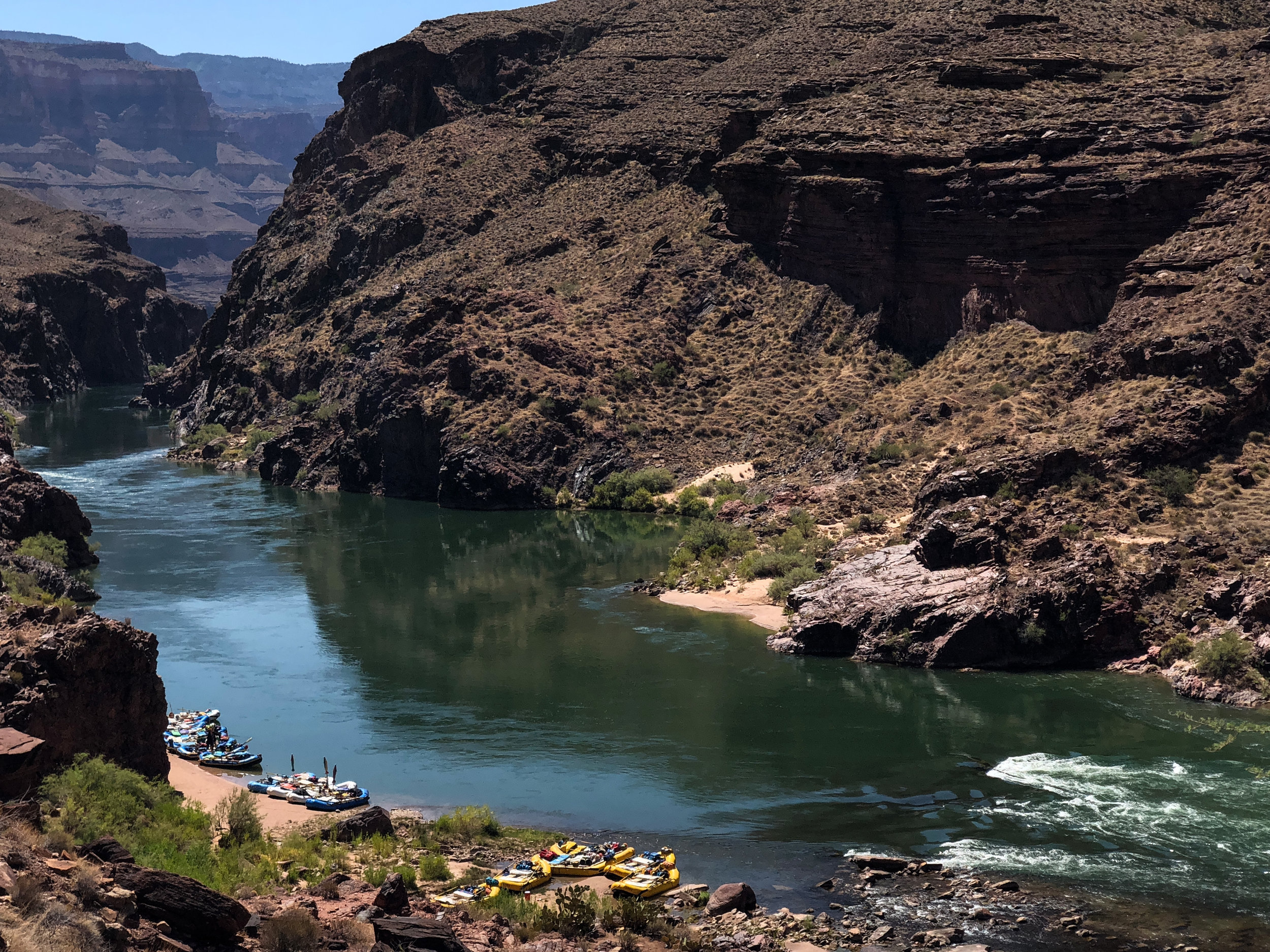



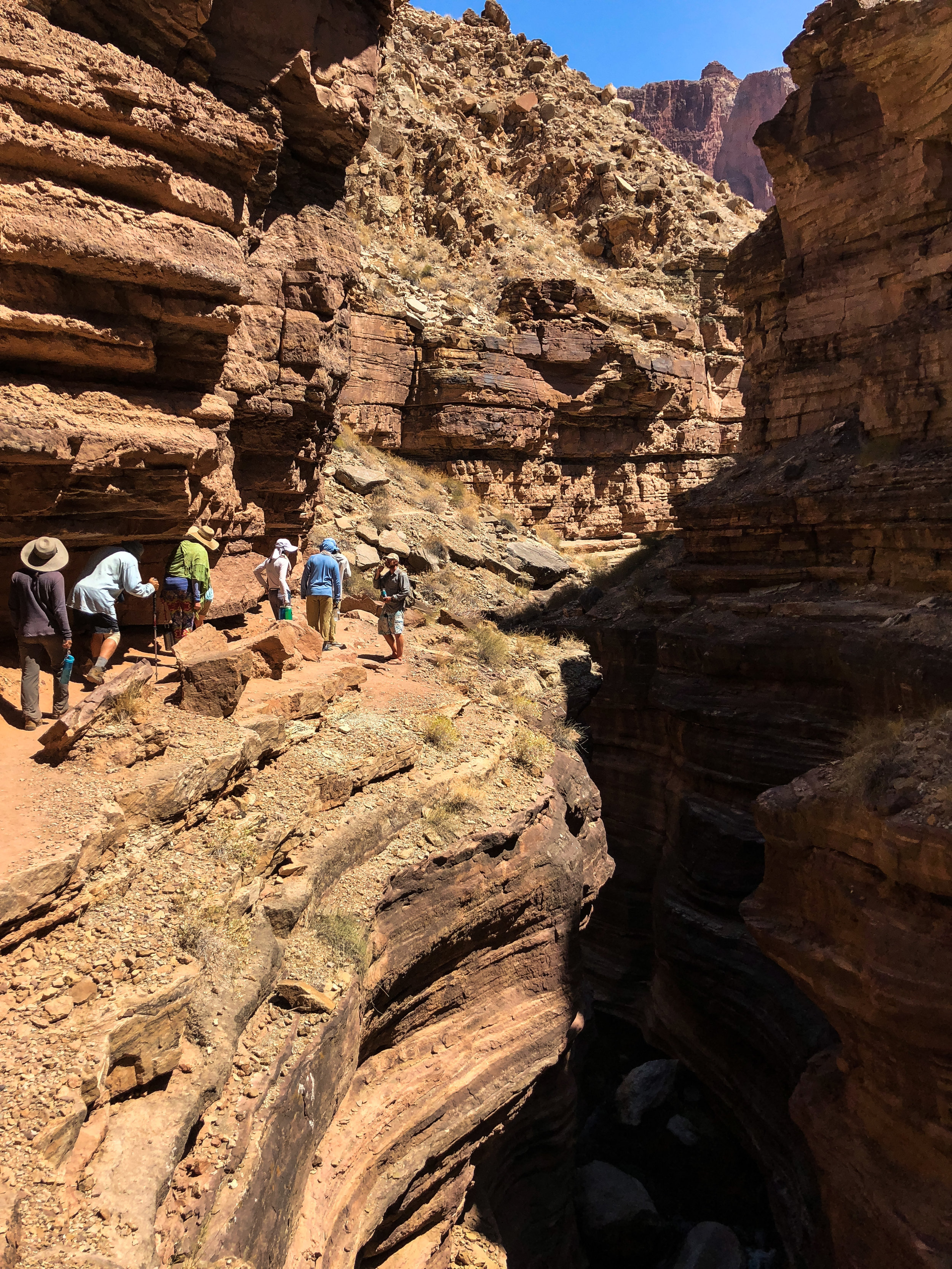
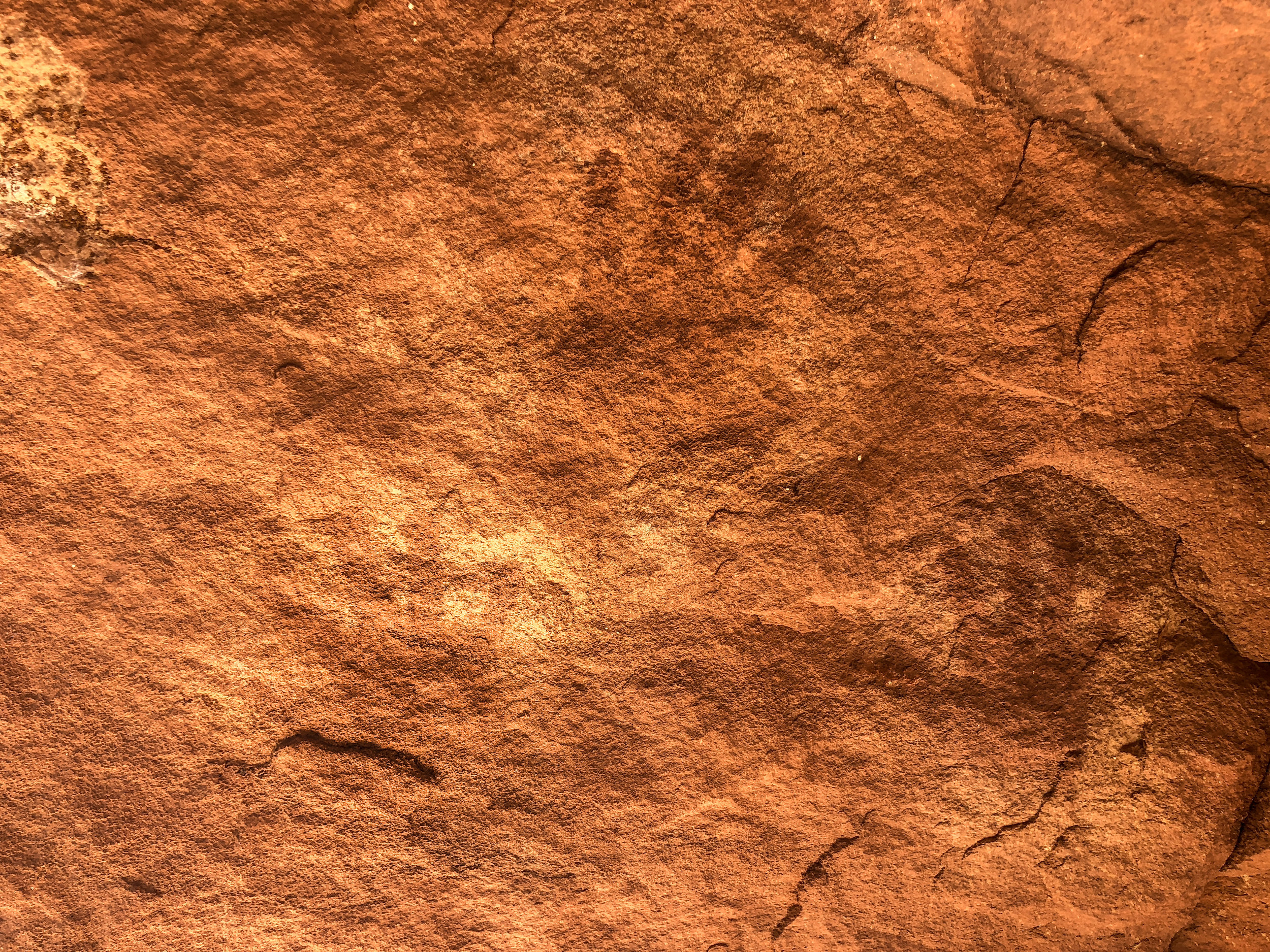
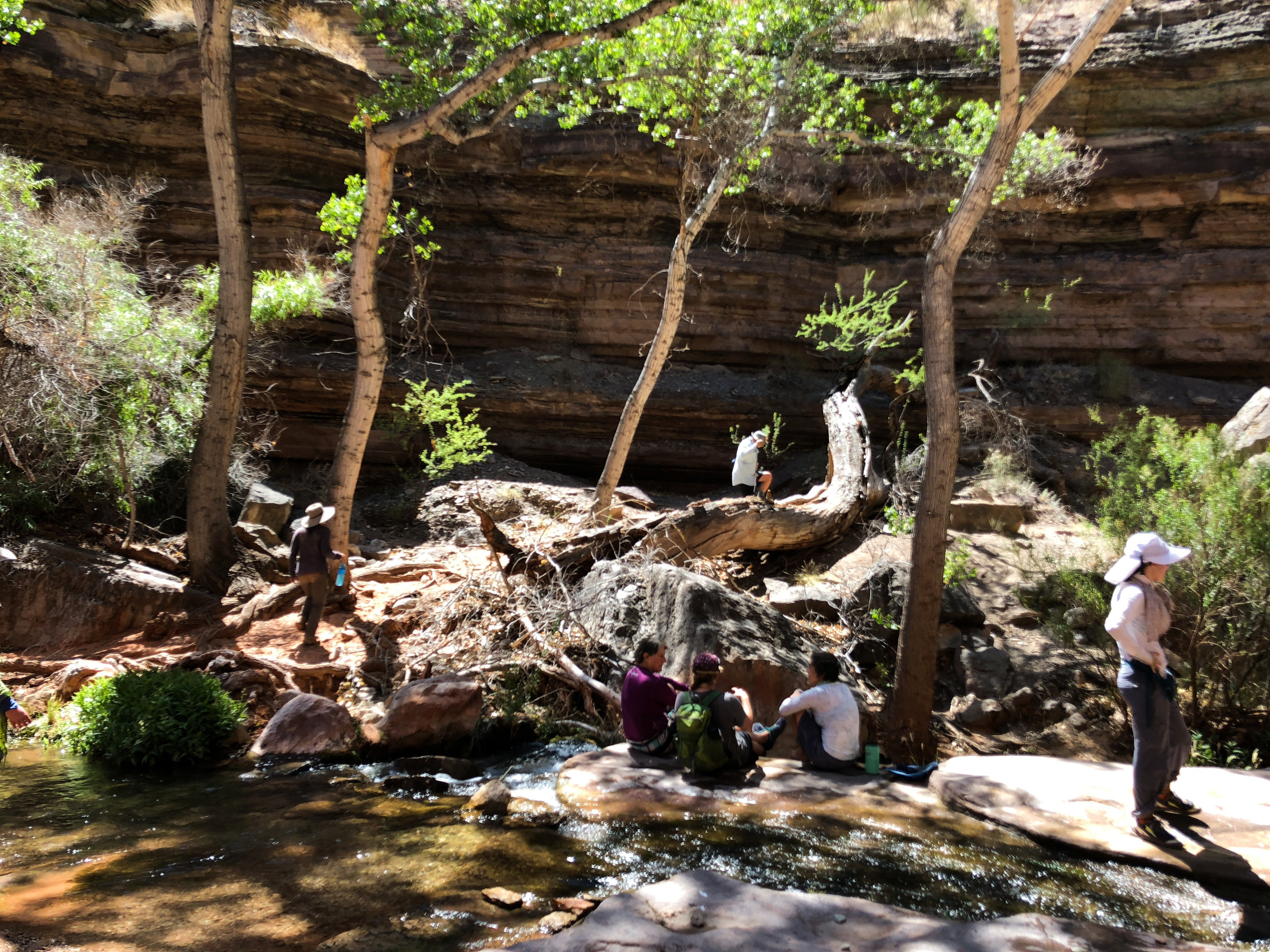
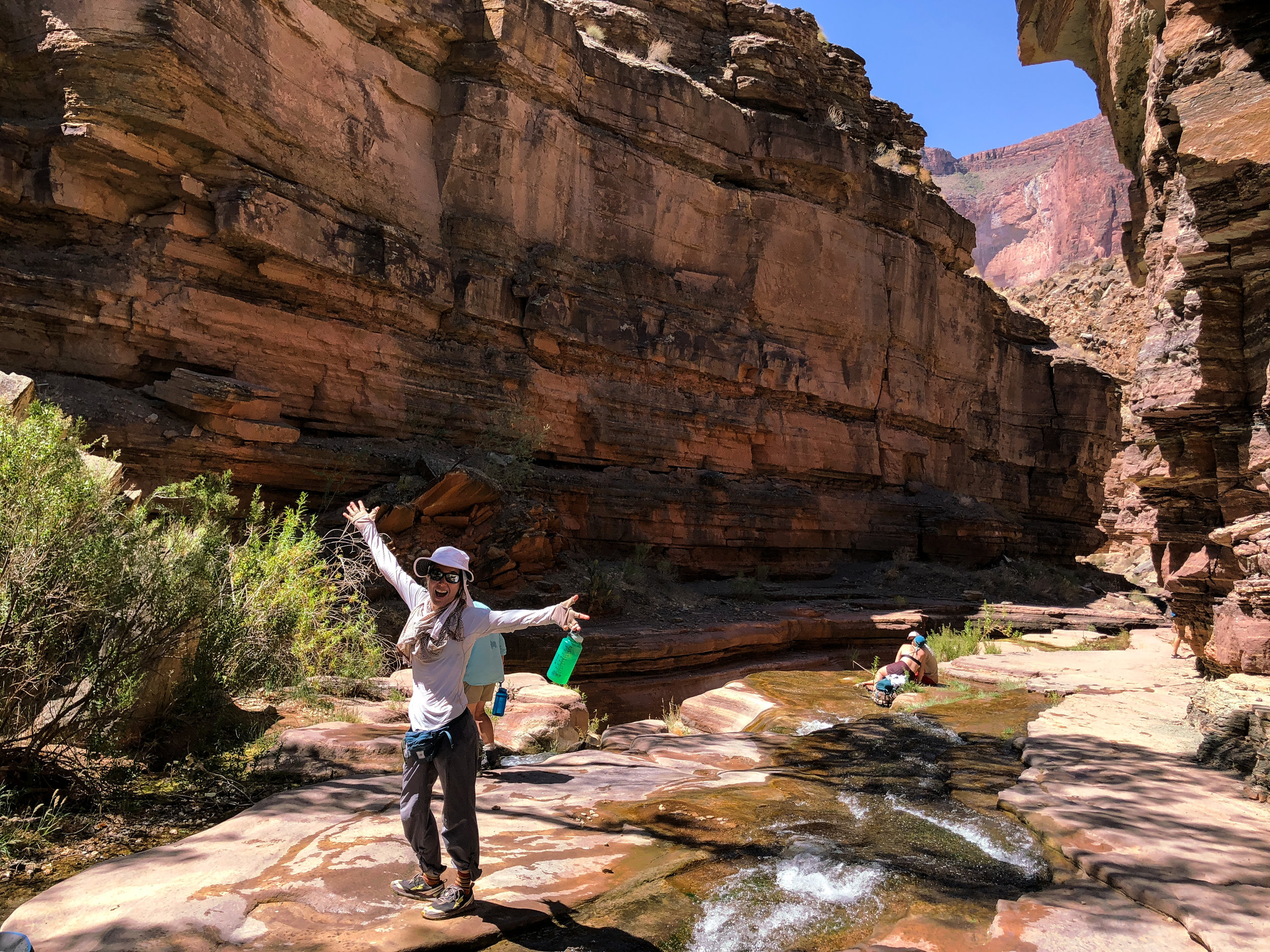
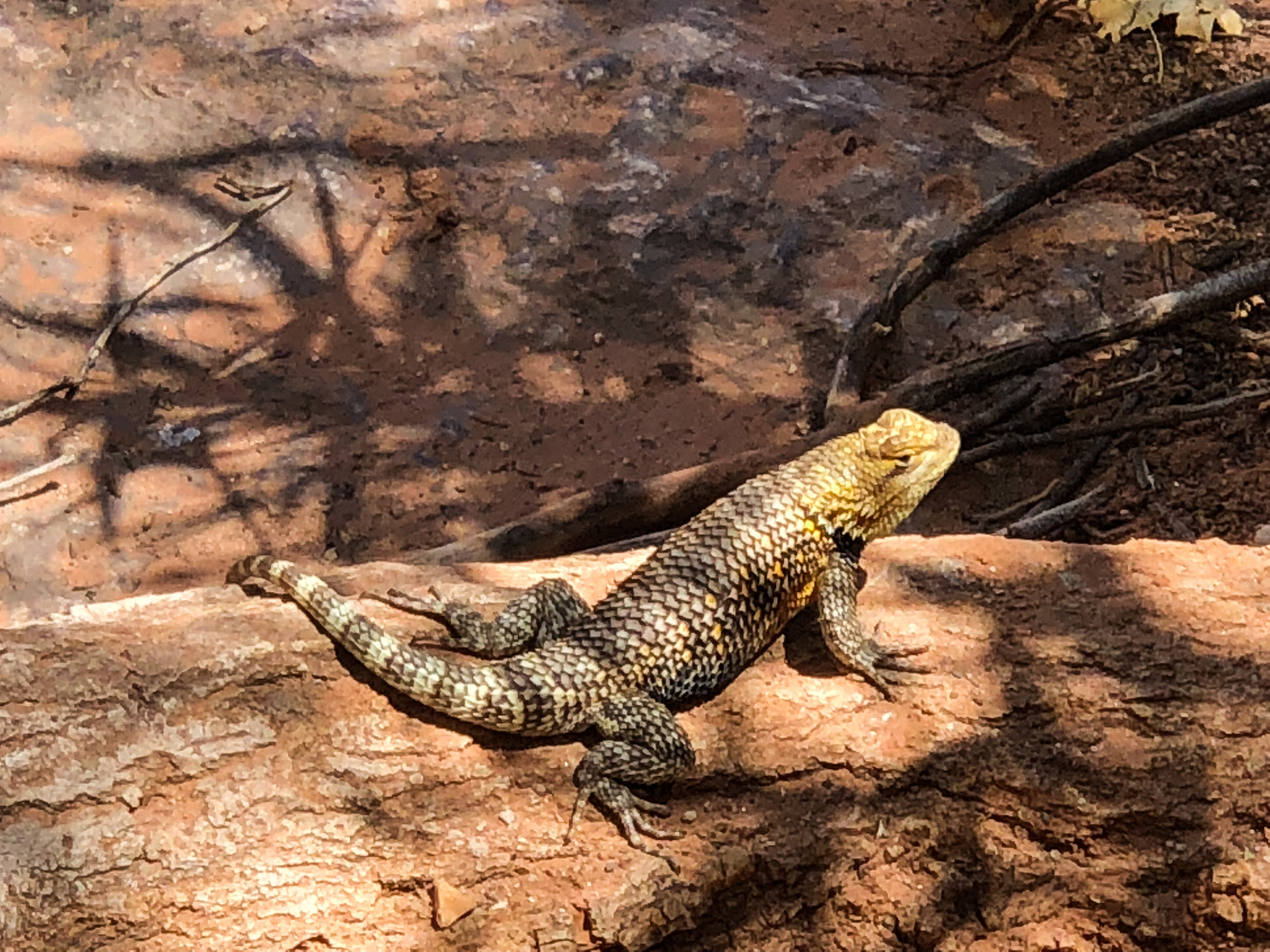

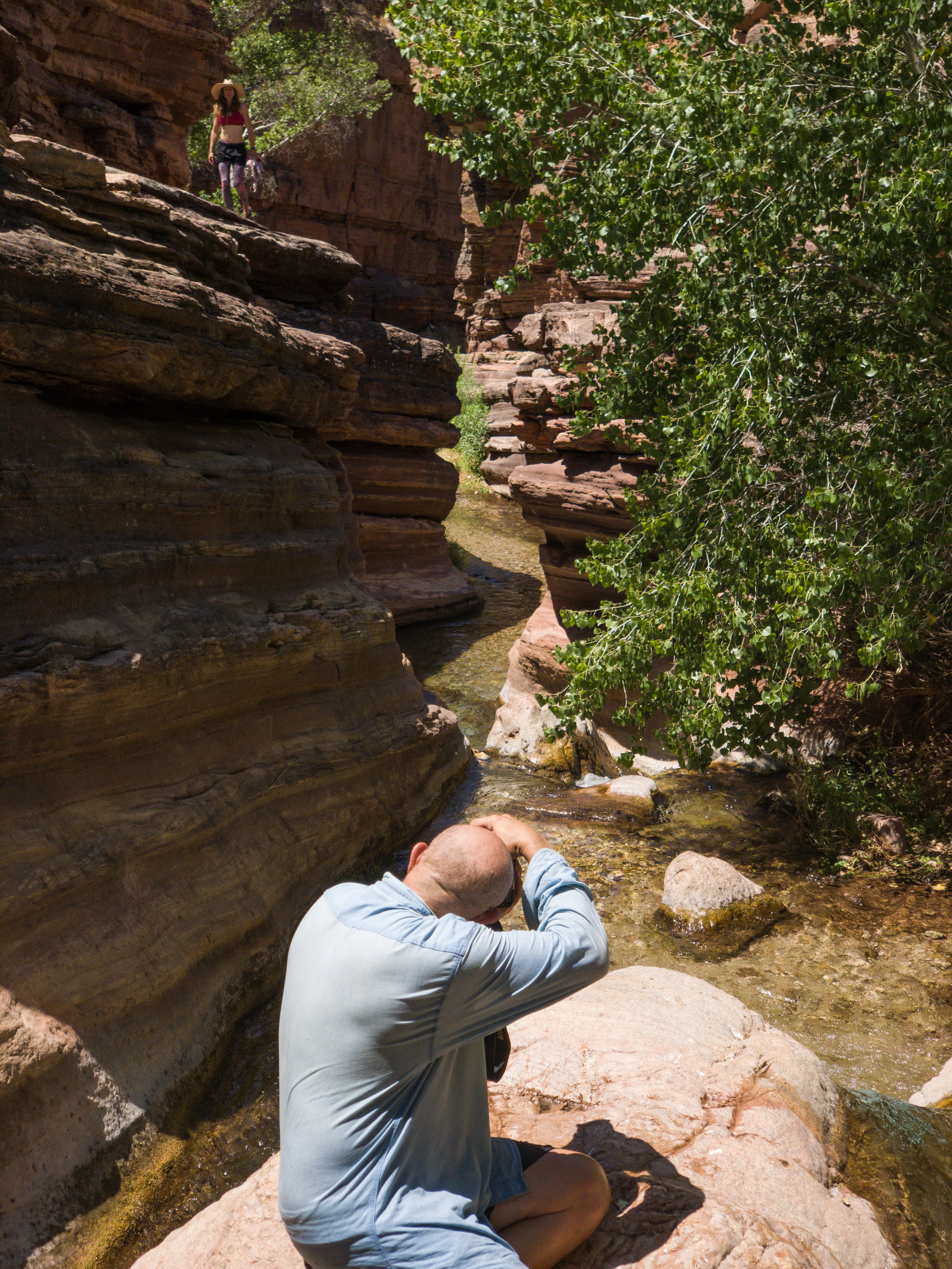
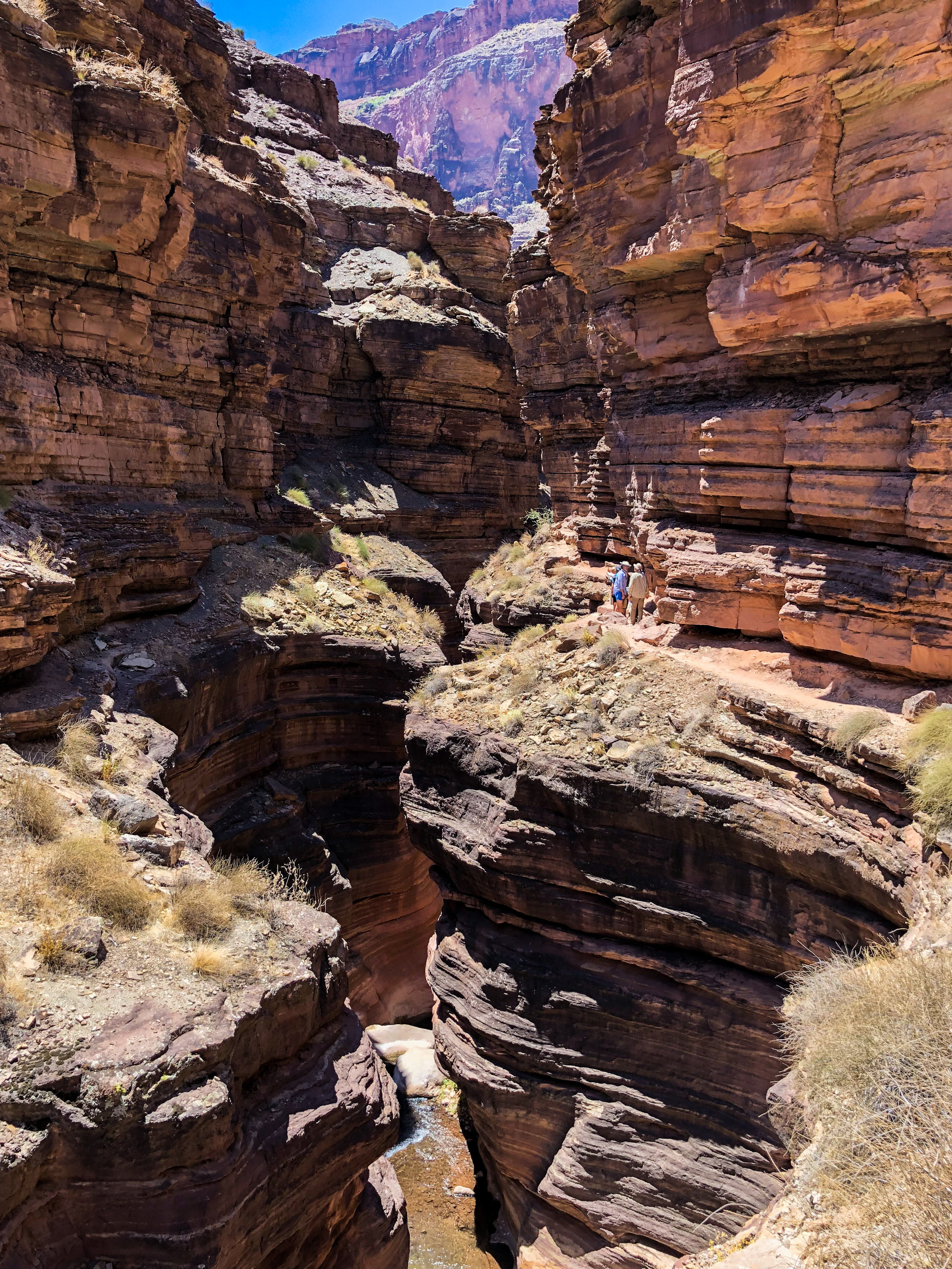
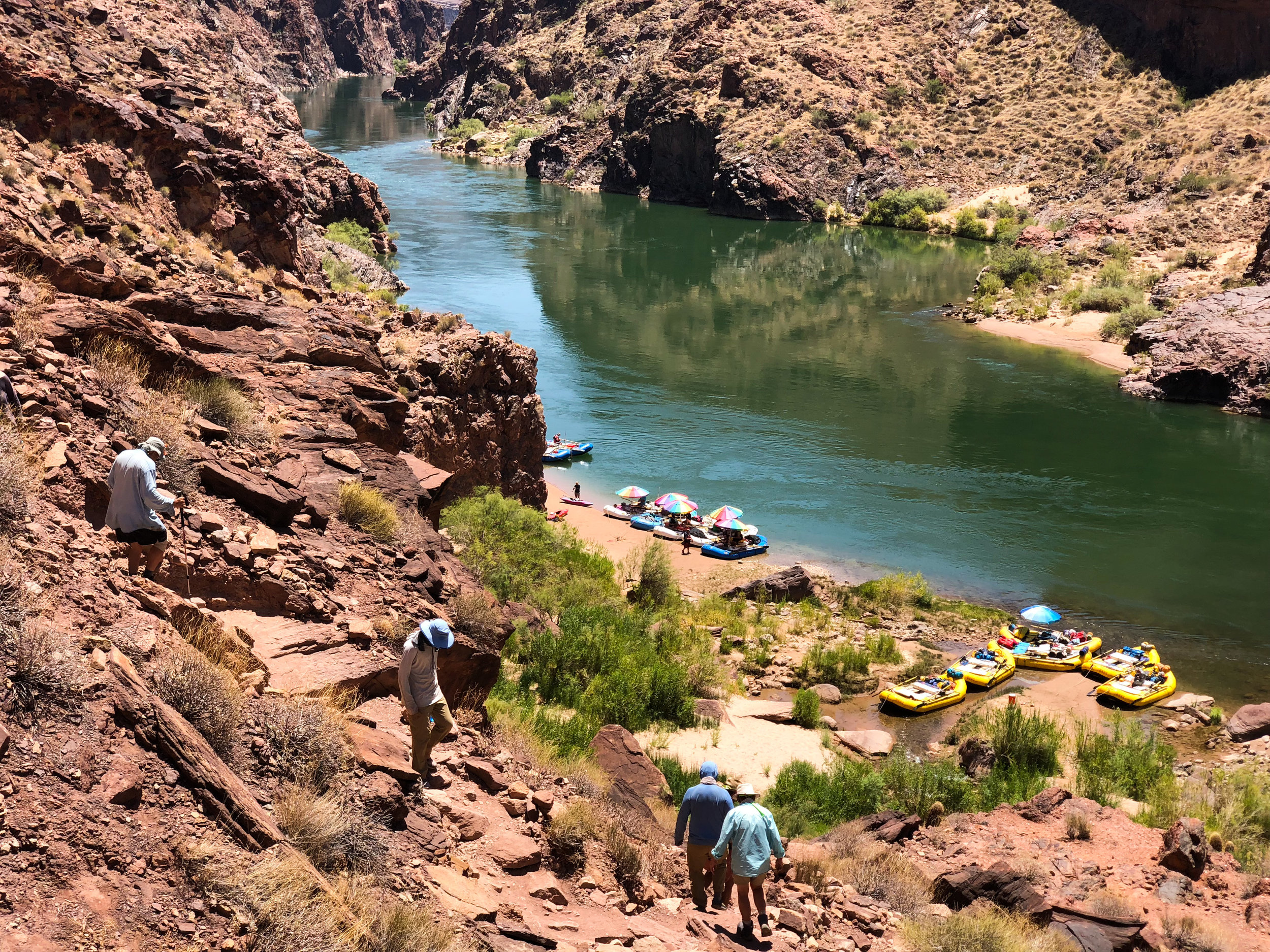
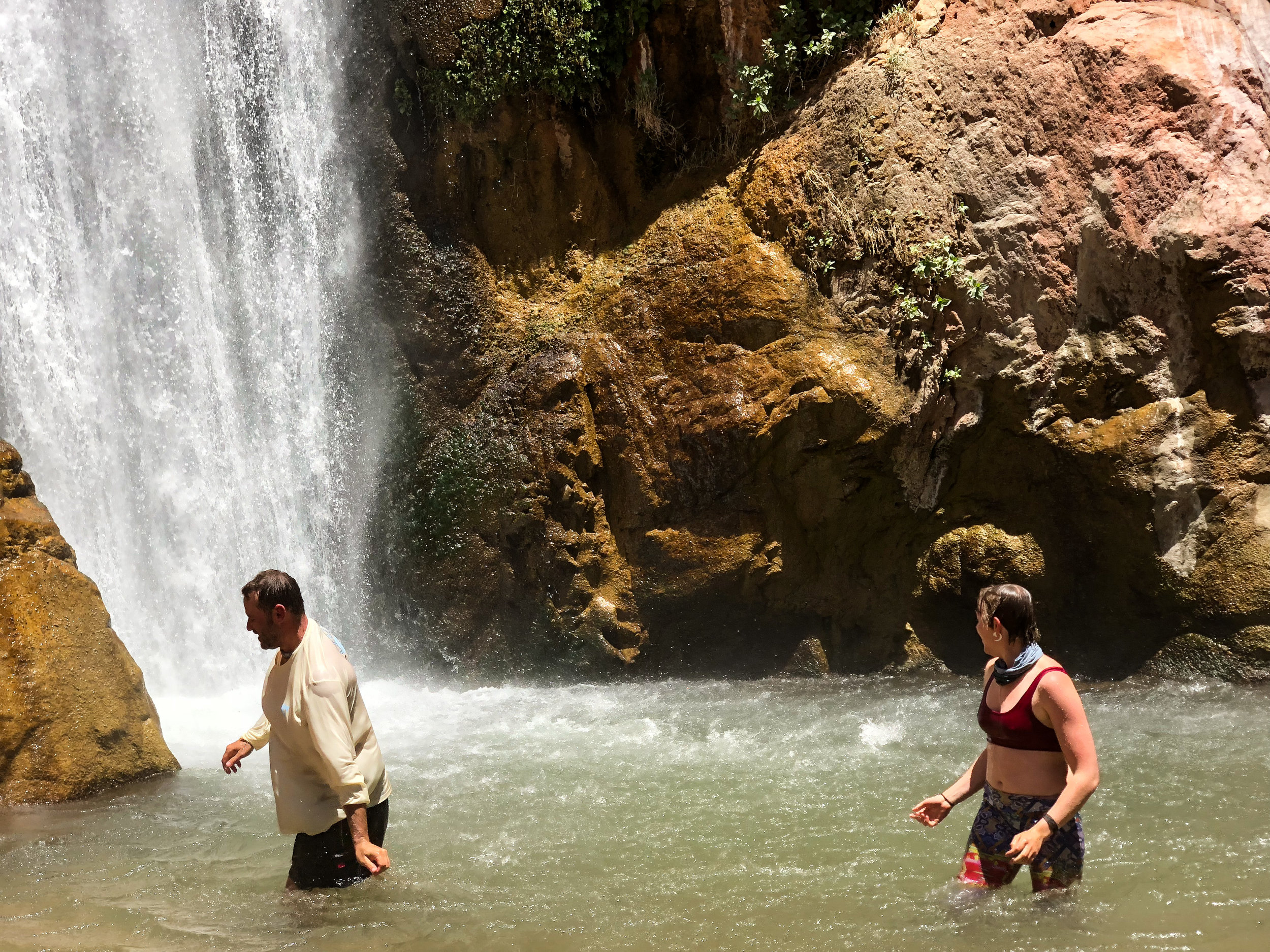
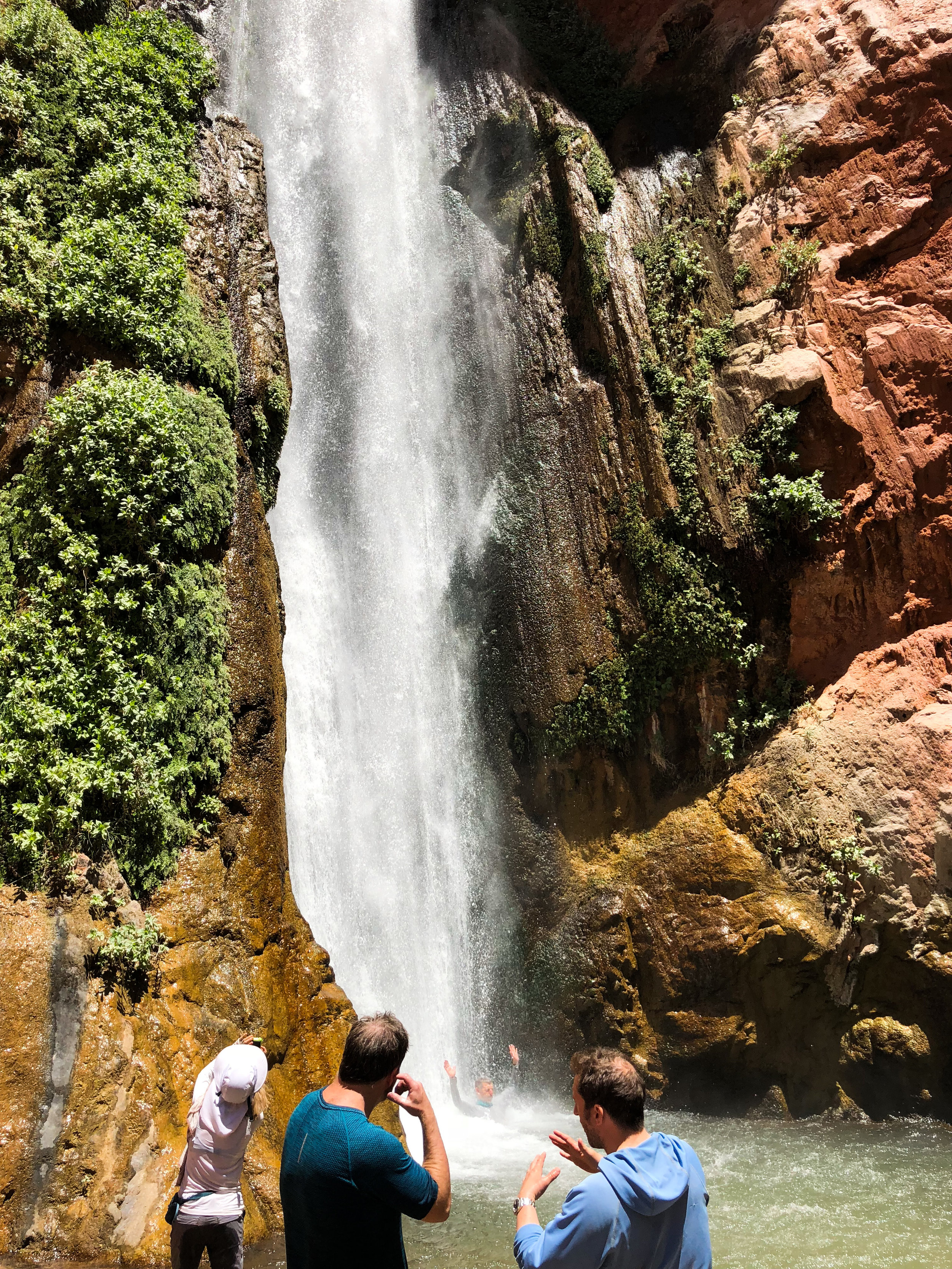
Books inside the Canyon
There was time to read each morning and afternoon. Many hikes and side trips to the slot canyons also provided an opportunity to enjoy a book.
I brought Why Honor Matters by Tamler Sommers. Tamler is an associate professor of Philosophy at the University of Houston and co-host of the Very Bad Wizards podcast along with David Pizzaro from Cornell. I enjoy the podcast quite a bit, so I bought the book.
Recommended books of the river tribe
Why Honor Matters explores how the social virtue of "honor" has been replaced by the individual virtue of "dignity" and what we lose as a result. Honor is a virtue that is earned through social recognition of respect for actions and character. Sommers claims honor is instrumental in building our social civilization. Honor is powerful. It motivates soldiers to willingly risk their lives in battle. But the powerful motivation inside honor also has a dark side. Honor killings being a vivid example. Sommers argues that we are losing something by eliminating honor as a virtue. We should find a way to utilize honor without losing control of this powerful force.
Another aspect of honor is justice. In honor cultures crime is personal. He observes our western culture’s elimination of honor creates an impersonal justice system where crime is committed against the state and the rights of the victim are not considered. He is certainly correct on these points. Sommers puts forth a solution he calls "Contained Honor" which allows us to retain the benefits of honor while containing the dark side. He advocates for a Restorative Justice System that allows the victim and the criminal to negotiate a penalty that both sides judge as reasonable. He cites many examples of this system being implemented and having great benefits in reducing future crime while providing the victim with a sense of justice and empowerment.
As reading was an important element of the trip we asked the group to share their favorite books. The list of favorite books was recorded in our trip journal.
Havasu Creek
Hiking up the trail of Havasu creek
One famous place deep inside the canyon is Havasu Creek. The water of Havasu Creek has the same milky turquoise color as the Little Colorado River. Havasu Creek is a sacred site for the Havasupai (Havasu = blue green water, Pai = people) tribe. The Havasupai lived in this area for over 800 years. About 10 miles up the creek is Havasu falls which is a spectacularly beautiful place. You can only hike and camp at Havasu falls if you get a reservation from the Havasupai tribe.
Havasu creek is another party zone. The boaters nicknamed it - Have-a-zoo. We beached our boats on a rock ledge. The colorful creek was full of kayakers enjoying blue green waters of Havasu.
The trail winds along the cliffs next to Havasu creek and sometimes crosses the creek. The colorful red rocks along the creek accentuate the stunning blue water. The bottom of the canyon is lush with green vegetation, including wild grape vines. We walked for about a mile until we found a private oasis with shade and a nice pool for swimming. Havasu is beautiful beyond words. I jumped off the rocks into the blue green pool. Then I did it again and again. After my swim I relaxed on a nicely shaped rock and enjoyed my book until my eyelids became heavy.
This is a special place. Havasu lies at mile 157 and our trip would end at mile 187. Everyone felt the preciousness of scarcity as we enjoyed these magical waters.
Gallery of Havasu Creek





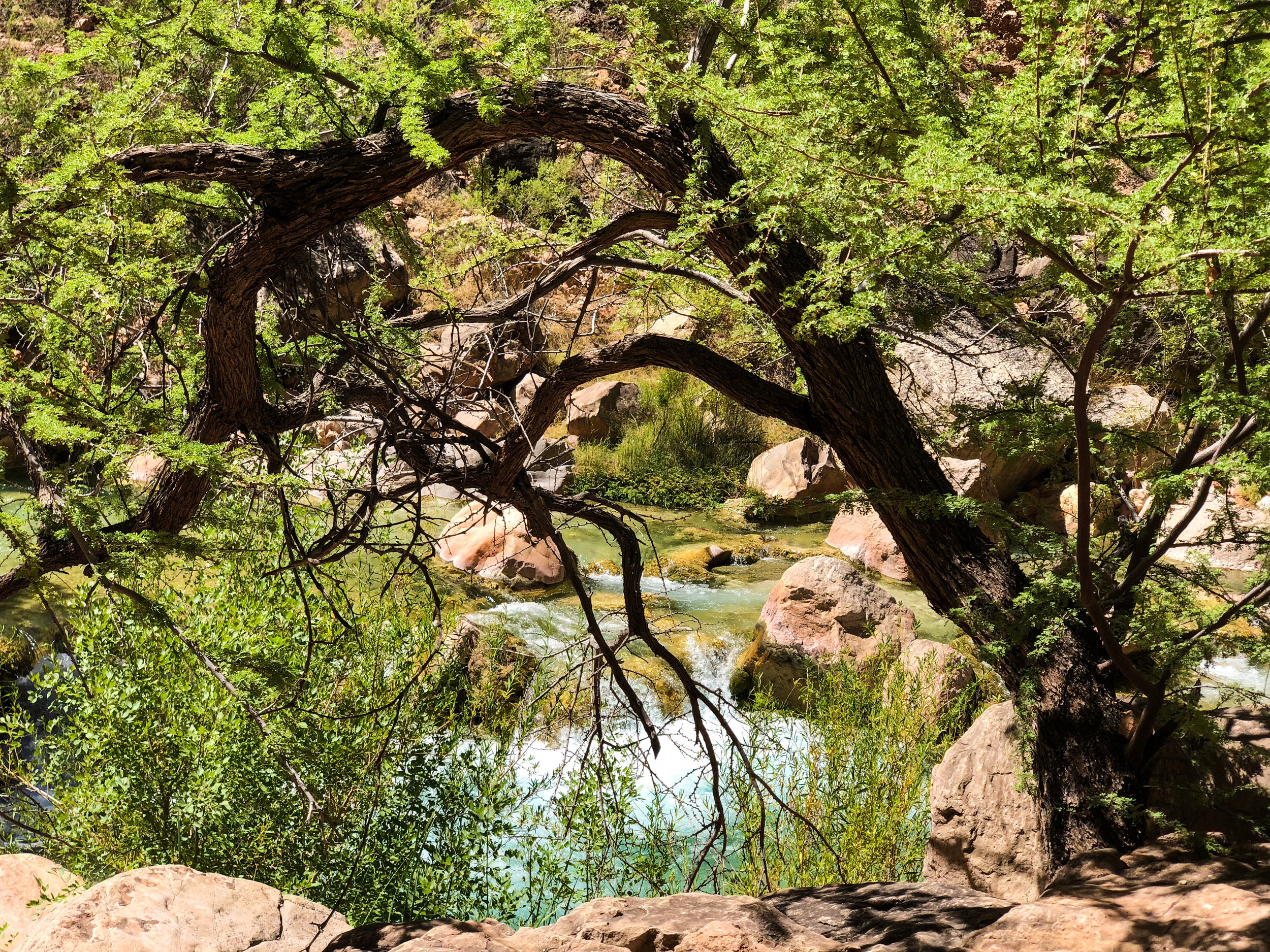
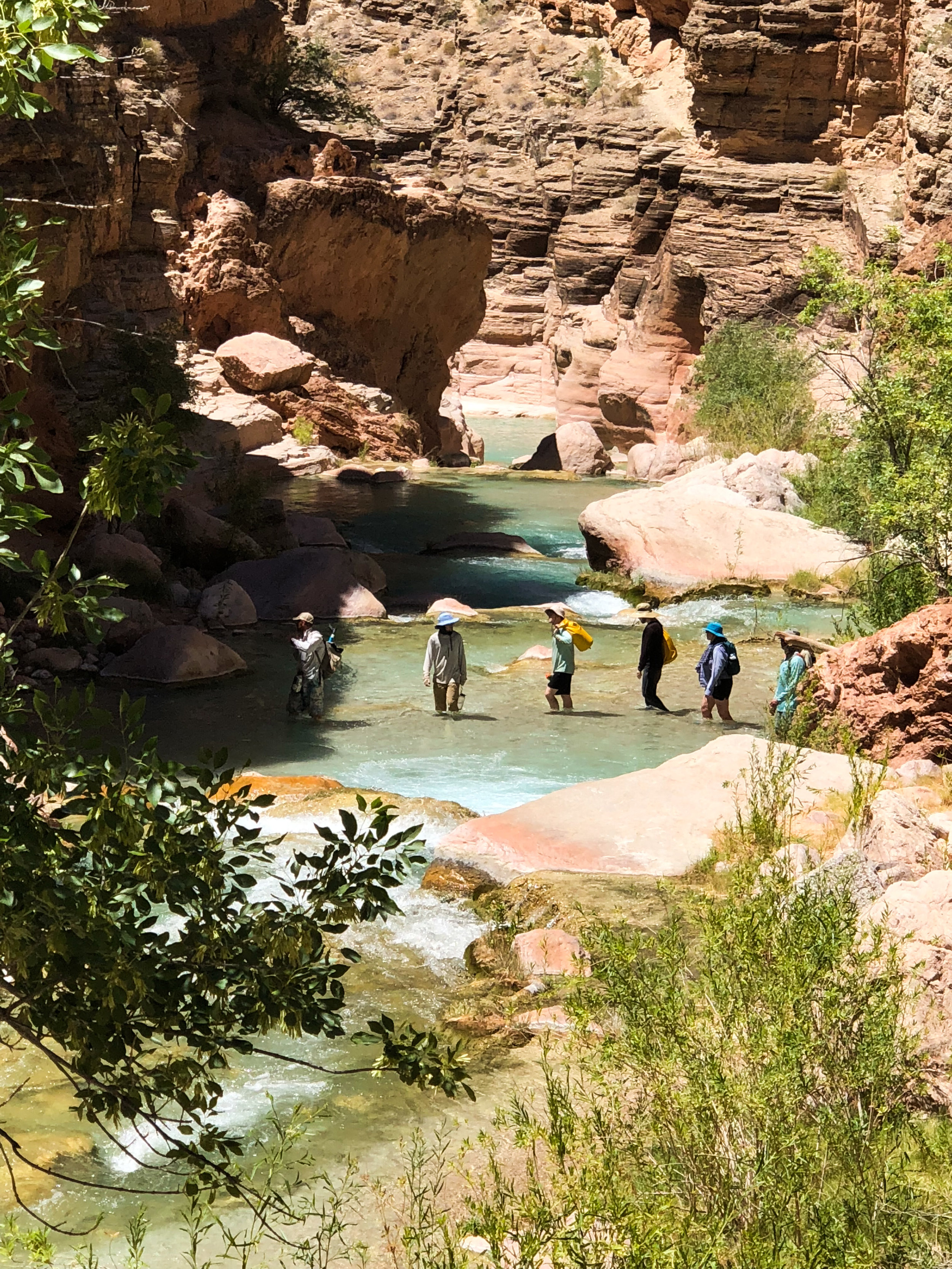
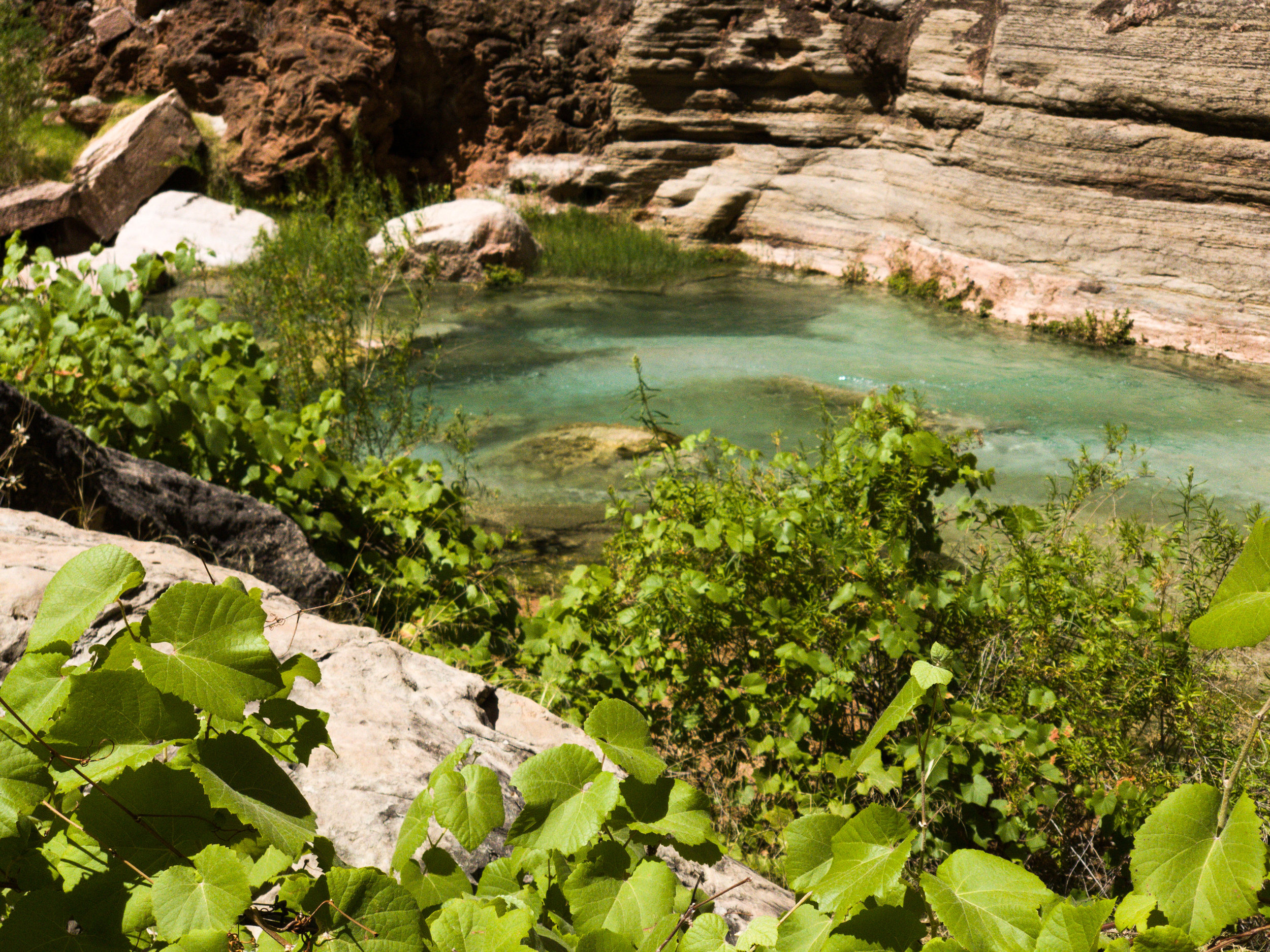
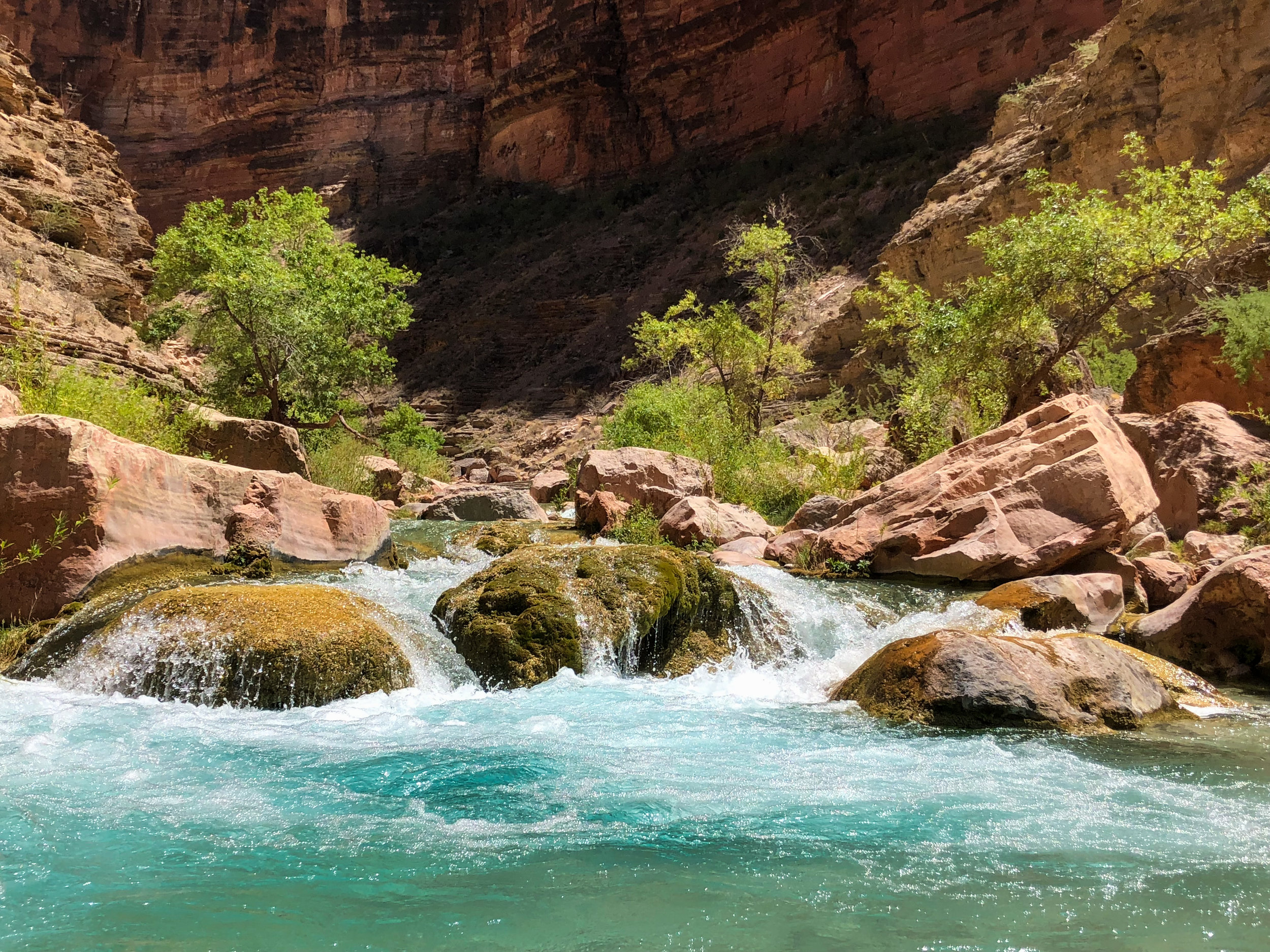
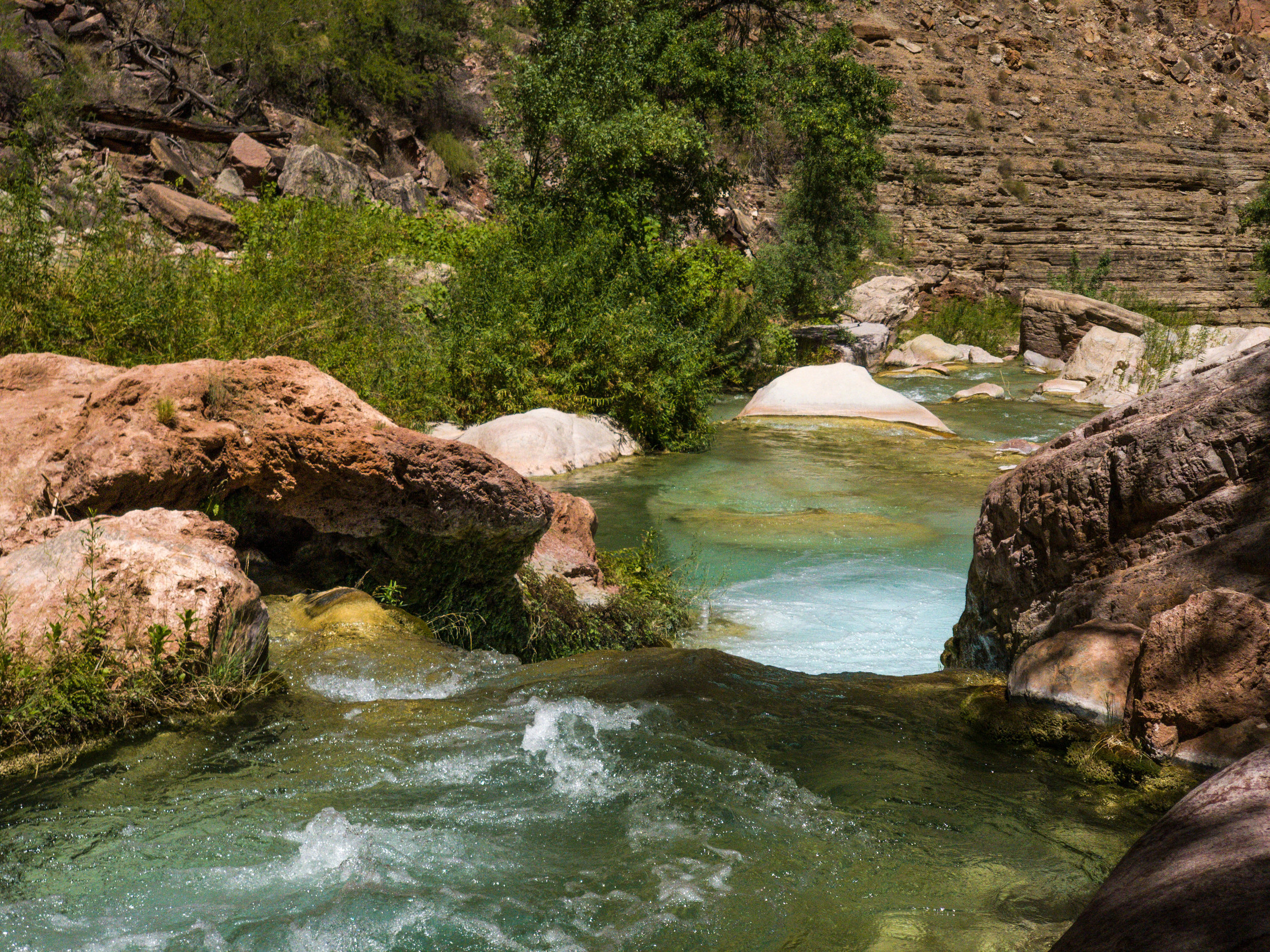
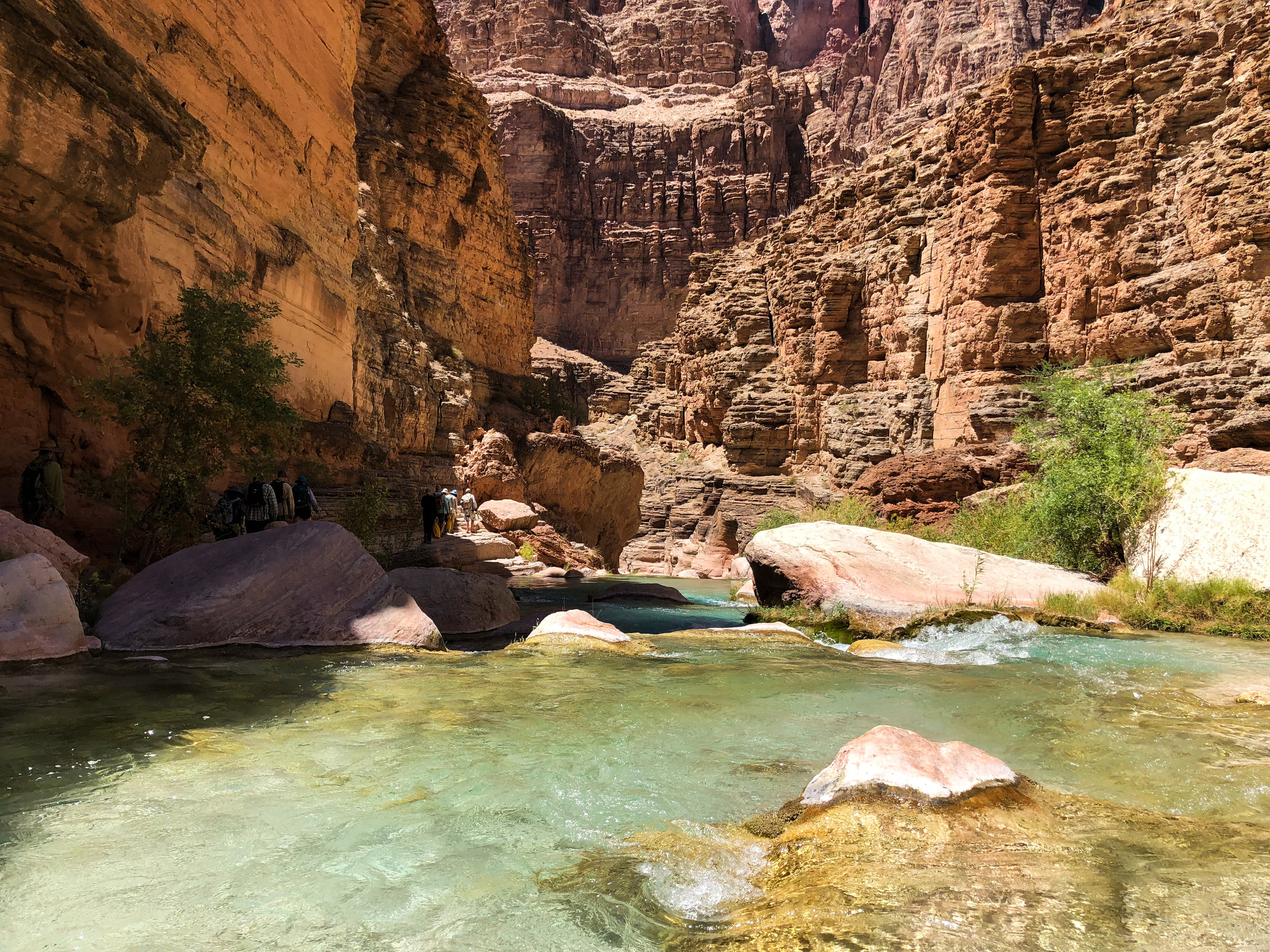


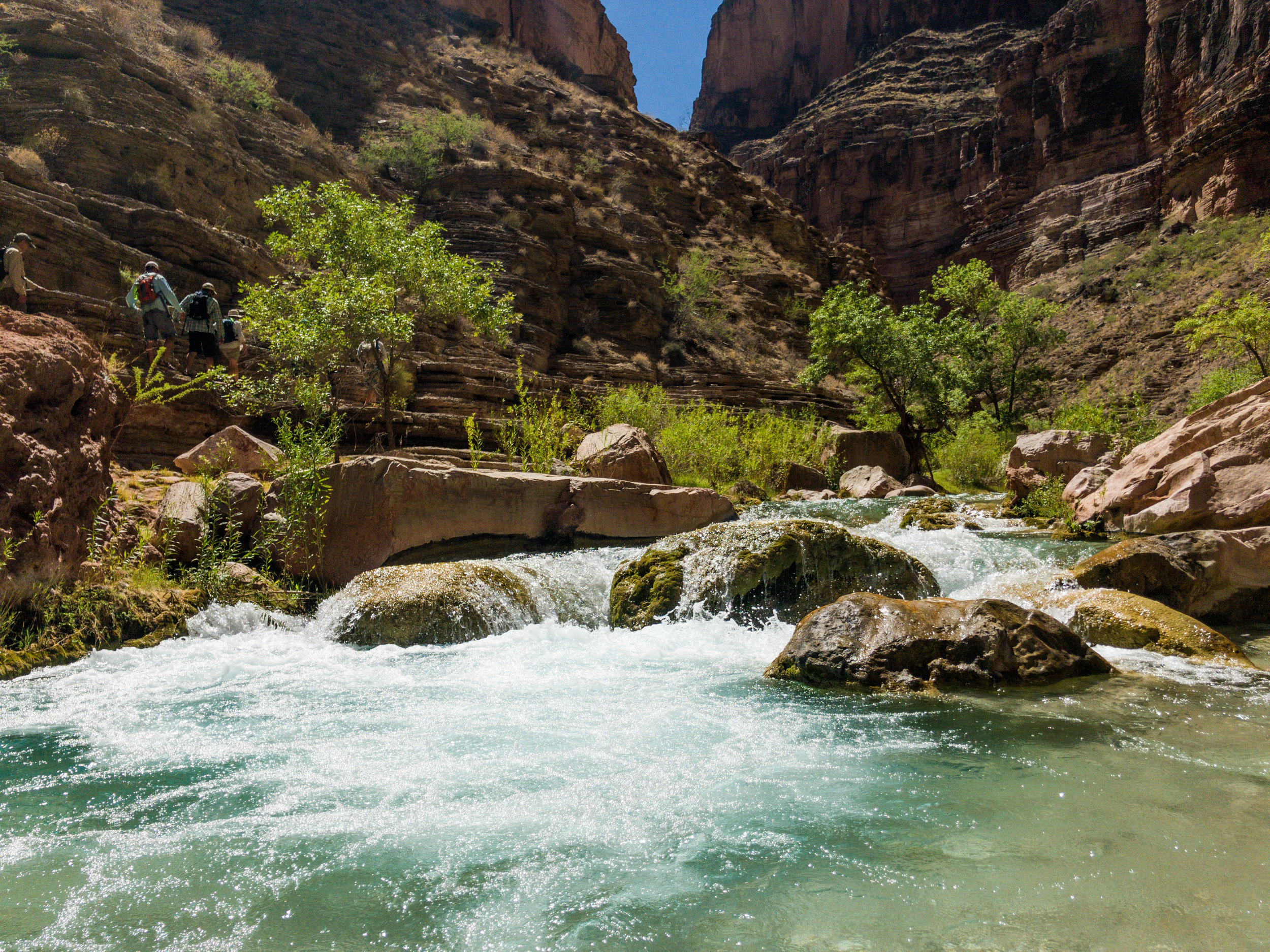
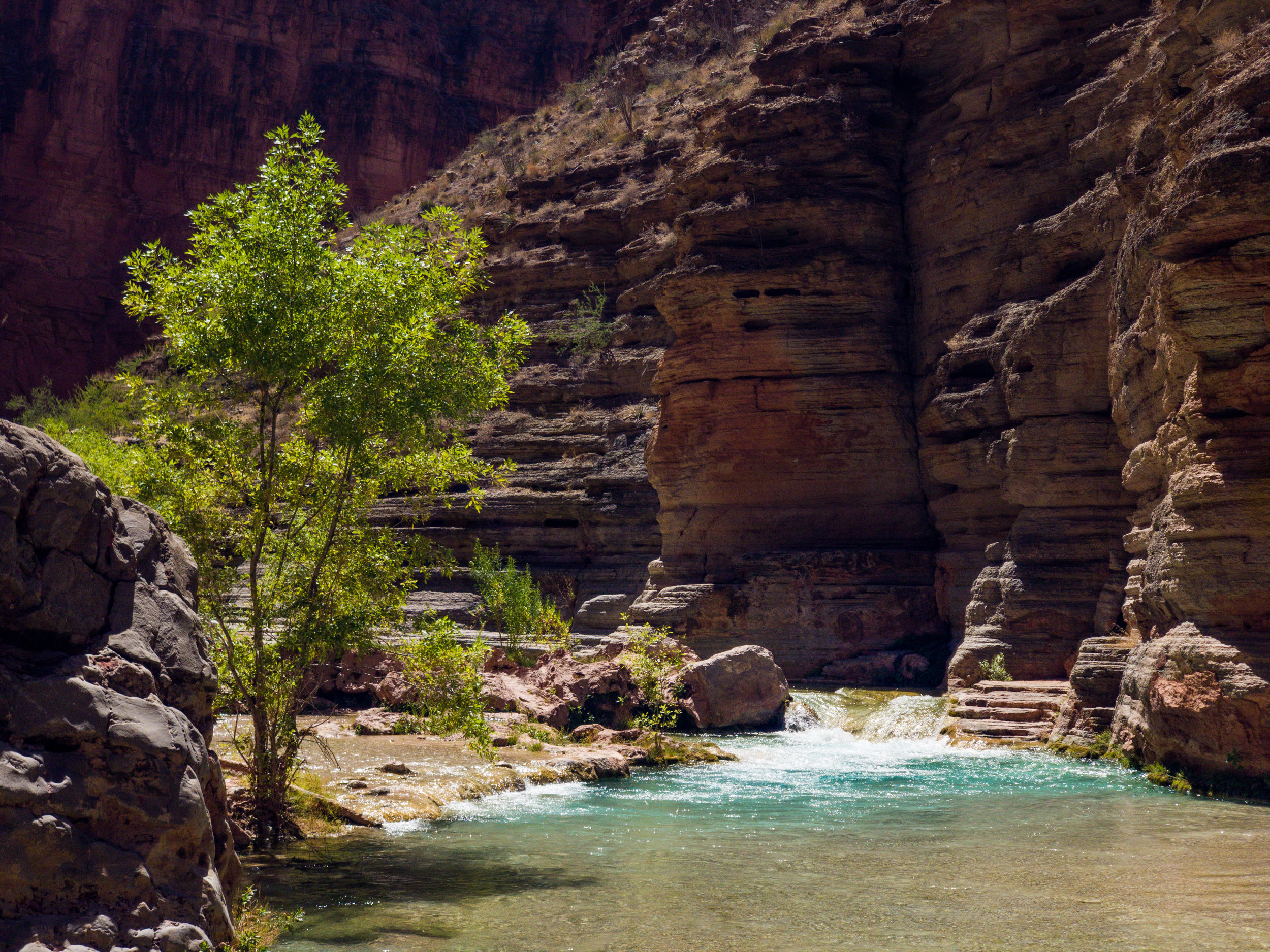
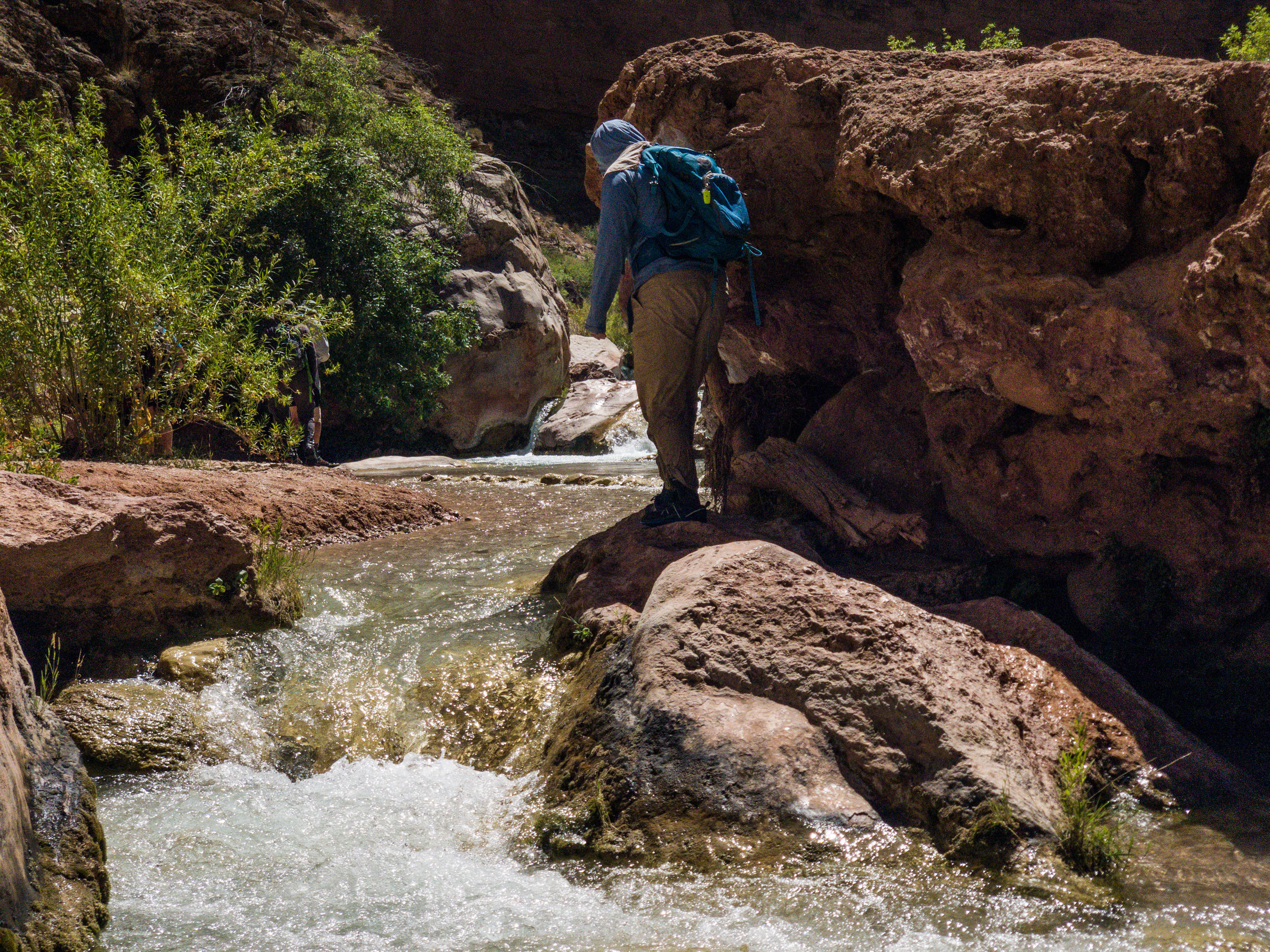

Final Days
2 nights and one full day of float remained. Tomorrow was Lava Falls and the next day we would depart this wonderful river in a helicopter. Life is change. There is a beginning and an end to everything. Our trip was going to end soon, but it wasn't over yet.
In camp we stayed up late into the night because our group wanted to make the most of our precious time together. One of the guests (David) is a physicist who makes presentations at a local observatory. With a green laser he pointed out constellations, satellites, and shooting stars in the dark sky. After our private sky tour finished we stayed up even longer. There were intimate conversations about life and how to live it.
Running Lava Falls
The tribe - our final morning together
Lava Falls Rapids is one of the largest and most powerful sections of whitewater in North America. Lava falls is the last section of big white water on our journey. The grand finale to a fantastic trip. I gave a detailed account our run down Lava Falls in Part 1. If you have not read it, you should.
After our run down Lava, time slowed down for us. With just a few miles to our final camp, we rested on a shady ledge just downstream of Lava. We savored our day while watching other groups make their way down stream.
Our last night on the river was the 4th of July. We all had that feeling of knowing something great is about to end. We enjoyed steak and hand made Gus’s chocolate for dessert. We listened to guitar music while meteors in the night sky were our fireworks.
The Last Day - Reentry to the World
Morning came and we awoke with a storm of emotions. We would miss our river friends and return to "our lives." We became accustomed to a world population of 24. Bu we would soon reconnect with friends and family as well as the internet, clocks and cellphones. On the river our lives existed in the timelessness of the present.
Our helicopter ride out of the Canyon to Bar 10 Ranch
Our morning float was only a mile. We said our goodbyes and exchanged email addresses.
Overhead was the rhythmic drumming of sonic booms created by swirling helicopter blades. The noise intruded the peace and quiet during our final float. The chopper descended to pick us up. We beached our boats, grabbed our gear and boarded the chopper. Our river trip was over.
In the chopper the cliffs were so close we felt like we could reach out and touch them. The "real" world became larger.
The Bar 10 Ranch sits on the edge of the Grand Canyon. They offer ATV rides, horseback rides, river rides and showers. Even though I bathed every day in the river this shower felt pretty nice. Some aspects of civilization are……….civilized.
We boarded a plane waiting for us at the Bar 10 airstrip and took off toward Las Vegas. Below us, the Colorado River flowed into Lake Mead and the Hoover Dam. Sadness filled our hearts.
After final good byes to the group, I entered the noise and chaos of the Las Vegas airport. The contrast of the airport to the river was traumatic. Hundreds of people rushed in all directions while staring at their cellphones. TV monitors blasted 24 hour news designed to outrage. What has become of our world? I decided it was my choice how much of this crap I would allow into my life. I had disconnected the technology parasite on this trip. I wanted to be mindful about reconnecting to it.
Cheryl was waiting for me when I landed in Salt Lake. With joyous excitement I shared this incredible story with her. She decided to join me on the next river adventure down the Grand Canyon, scheduled for 2020.
Thats my story. They say a story is worth 1000 words…….. we hope you enjoy these images. While photos cannot convey the beauty of the Grand Canyon, they are the best we have.


